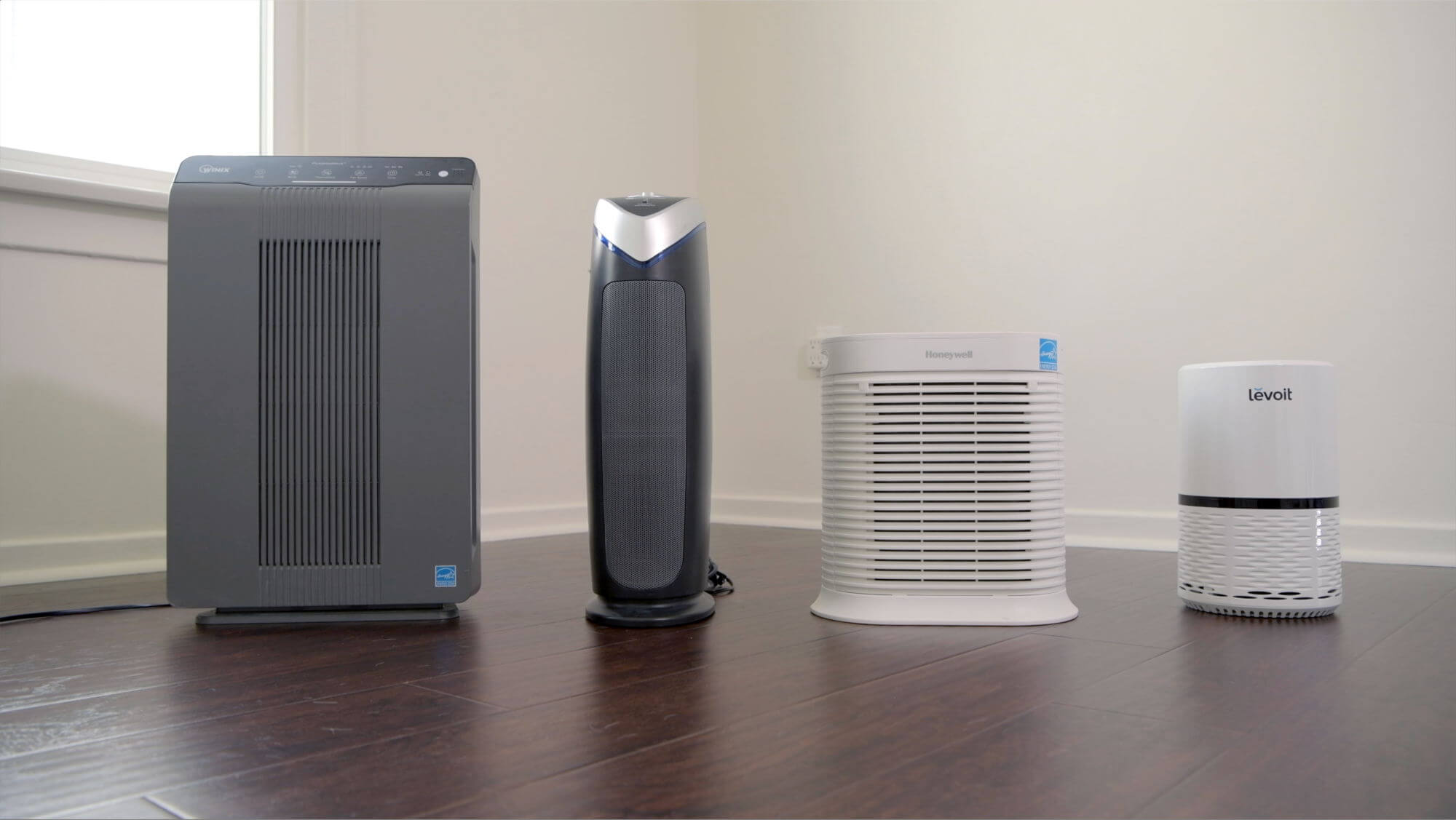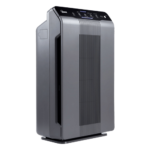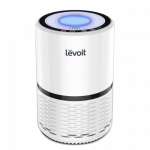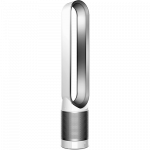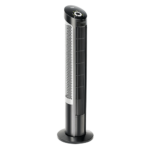The post The 7 Best Vacuum Storage Bags for Clothes appeared first on Your Best Digs.
]]>The 7 vacuum storage bags we tested
| Product | Price | Airtight Seal | Pump Effectiveness | Sturdy Zipper Lock | Value |
|---|---|---|---|---|---|
| Spacesaver | $$ | 10/10 | 9/10 | 10/10 | 9/10 |
| GONGSHI | $$ | 10/10 | 7/10 | 10/10 | 10/10 |
| Amazon Basics | $$ | 10/10 | 10/10 | 10/10 | 8/10 |
| Storage Master | $$ | 10/10 | 7/10 | 10/10 | 9/10 |
| BoxLegend | $$ | 10/10 | N/A | 10/10 | 8/10 |
| HIbag | $$ | 8/10 | 6/10 | 5/10 | 10/10 |
| Simple Houseware | $$ | 1/10 | 5/10 | 1/10 | 7/10 |
Important features to consider
Vacuum storage bags are a must-have for storing seasonal use items in a small space. Made of durable, lightweight polypropylene plastic, they come in four or five different sizes and can hold sweaters, blankets, comforters, towels, or any bulky fabrics, which are then sealed inside and compressed flat by removing air with a vacuum cleaner hose or a hand pump.
Most brands claim that their bags decrease volume by 80 percent, which then makes the deflated bags easy to store in a closet, attic, garage, or even under the bed. So you could potentially save a lot more space than only separating your clothes out into large storage containers. Vacuum sealer bags are also ideal for protecting woolens from moths and all fabrics from mold and mildew.
Sizes
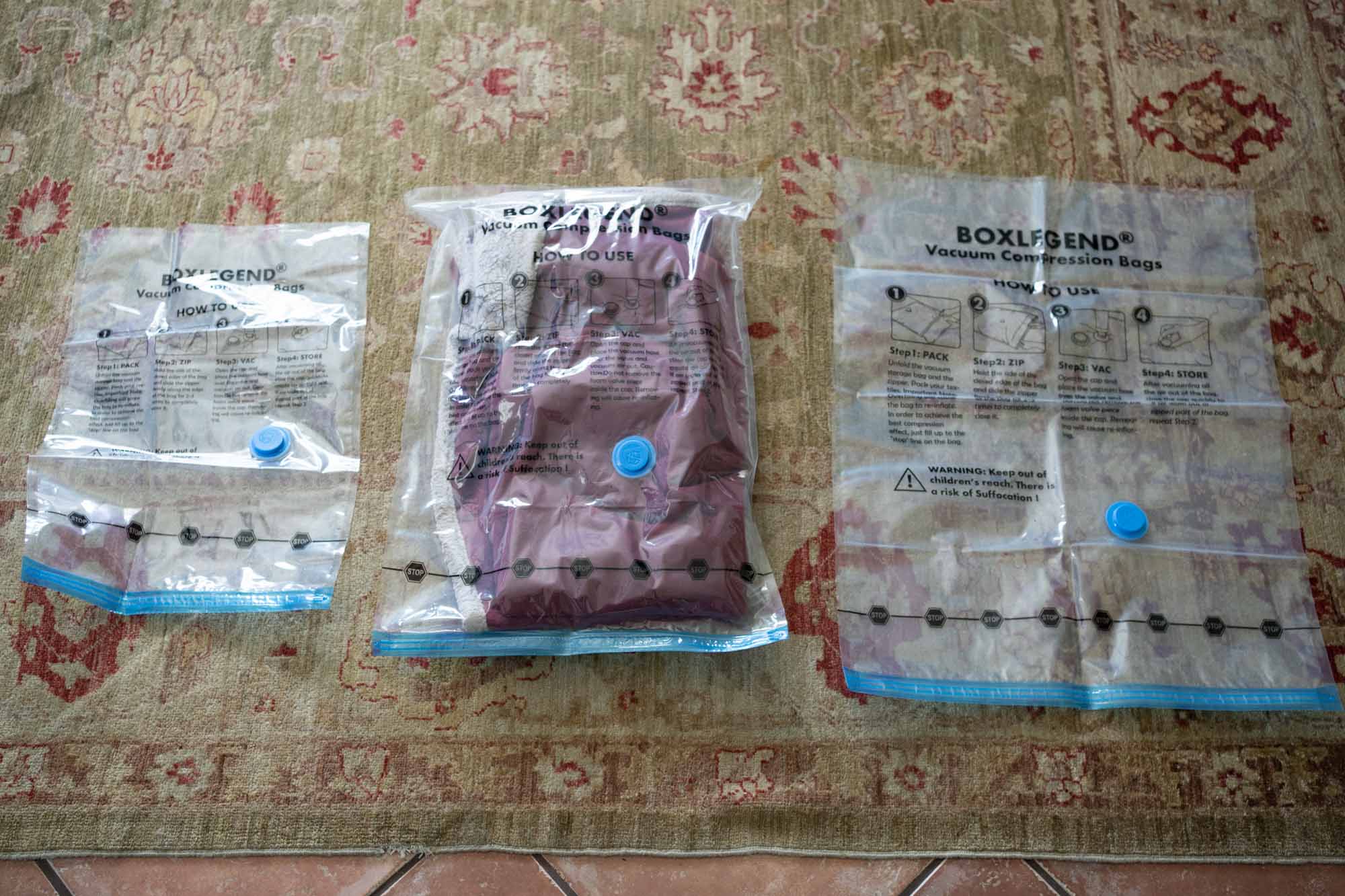
Almost all storage bags are available in certain sizes: jumbo or extra large (approximately 30″ x 40″), large (24″ x 32″), medium (20″ x 28″), and small (16″ x 24″). They can be purchased one size per package or a combination of sizes per package. A few brands offer a travel size, which are designed to fit carry-on luggage. The travel size, however, is not a vacuum sealer bag; it’s basically a large Ziploc bag that you need to squeeze out the air as you roll the clothes inside into a cylinder.
Zipper lock
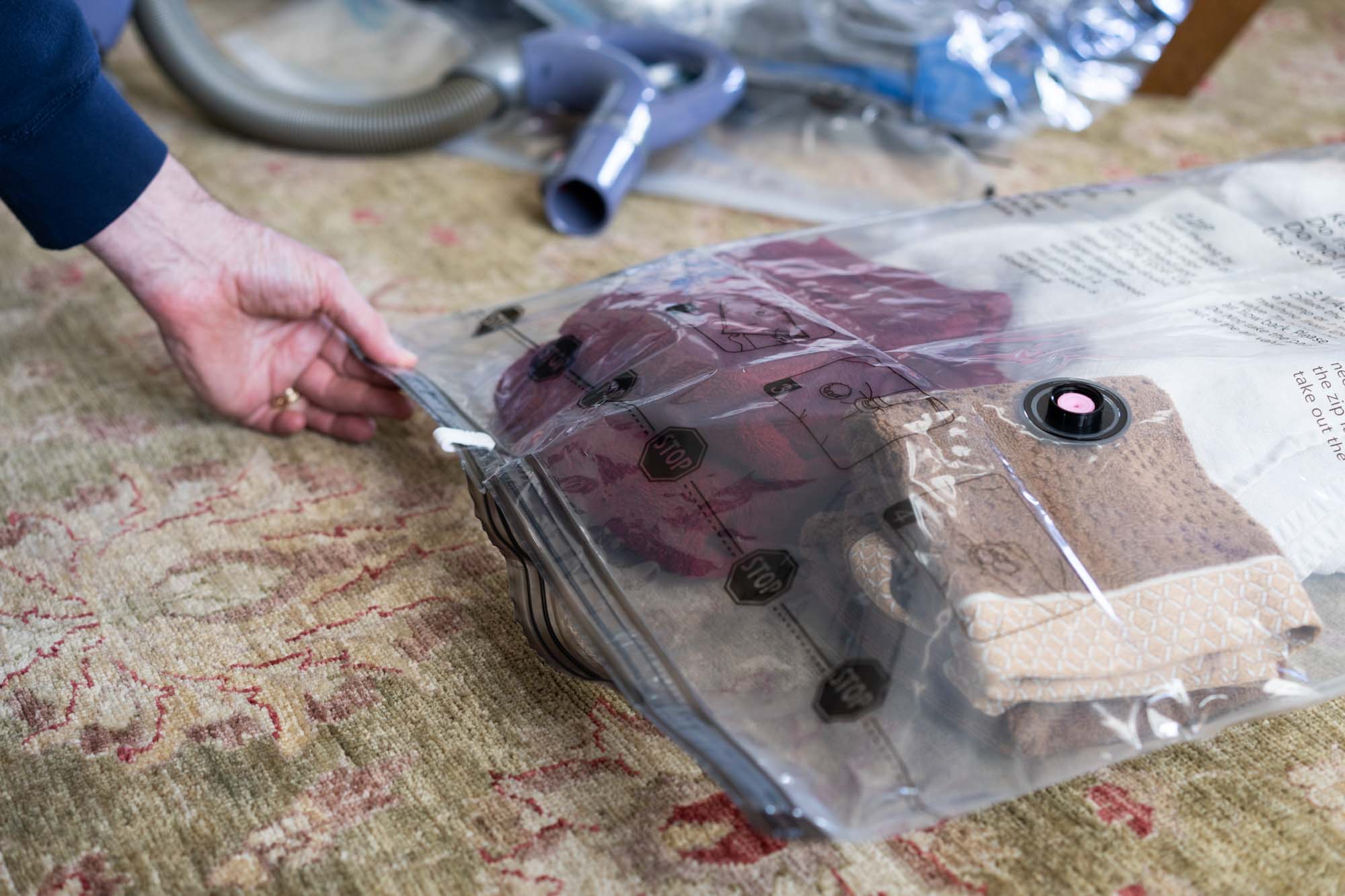
Vacuum storage bags have a large zipper lock, exactly like a food storage bag but twice as strong. It’s sealed by running a plastic clip along the length of the zipper lock. The better-constructed bags, like our top picks, Spacesaver, GONGSHI, and Amazon Basics, can be sealed with one or — at the most — two zips without needing to reinforce the seal with your fingers. In these bags’ cases, the zipper locks and clips were sturdily made and sealed tightly. Other bags we tested had flimsy zipper locks, and we needed to run the clip over the zipper four or five times as well as press the seal together with our fingers.
Hand pump
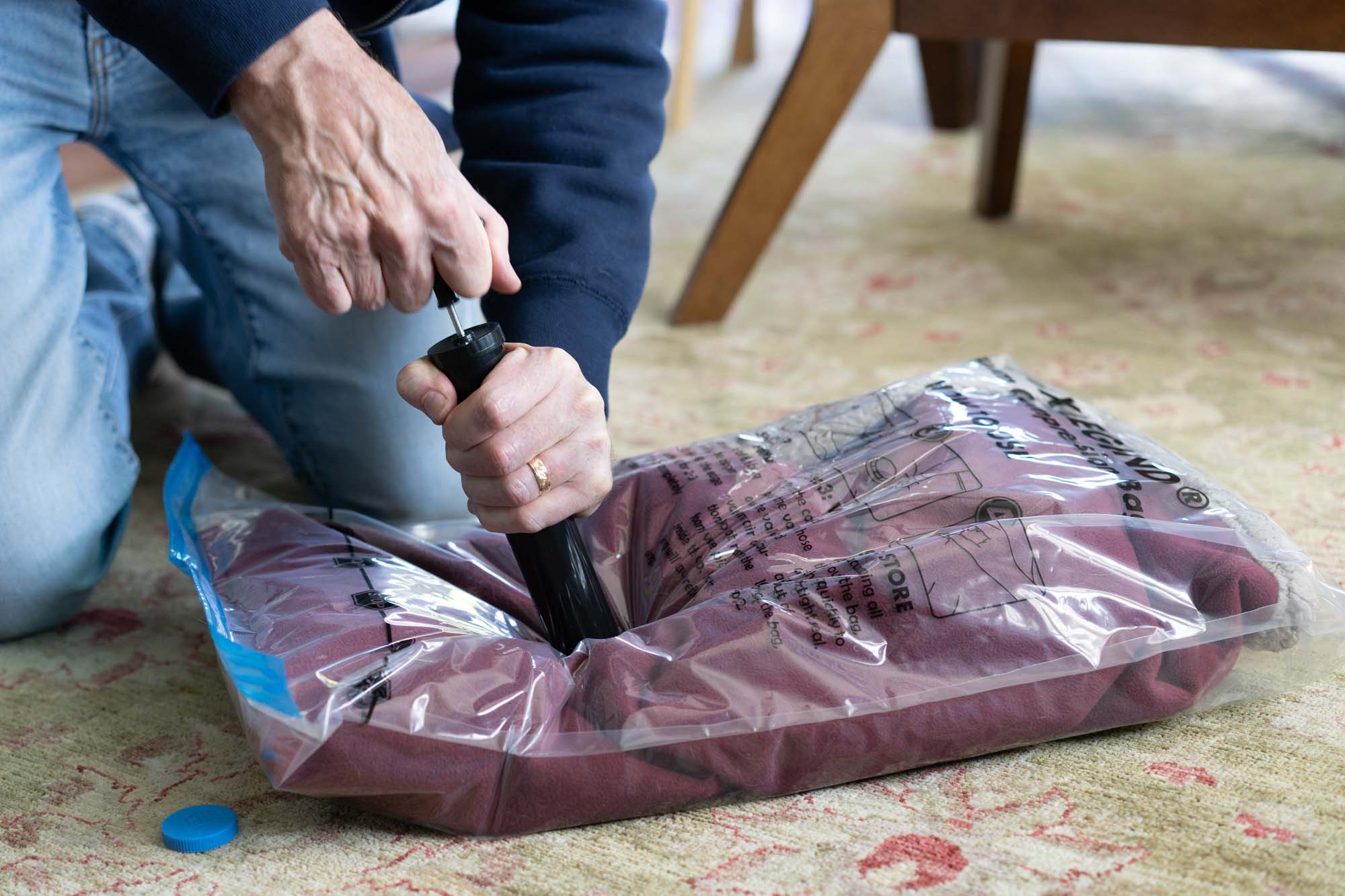
Most of the vacuum storage bags we tested came with a hand pump that you would use when traveling or when a vacuum isn’t at hand. All are made of plastic — a few had a metal plunger rod — and measure approximately 8″ in length and 2″ in diameter. The pump is screwed into the sealer valve (if you were using a vacuum, the hose is placed over the valve), and with a series of rapid pumps, air is removed from the bag. With the jumbo or extra large bags, the hand pumps were pretty useless and tiring to use, since a lot of elbow grease was required. However, overall, with all other bag sizes, the pumps were easier to use and were mostly effective in sealing the bags in a couple of minutes.
Fabric wrinkling
When the bag is vacuum-sealed, the plastic often shrink wraps tightly around the fabrics. When the bag is opened, the fabric is deeply wrinkled in the areas the plastic touched. You will also notice an impression of the valve on the fabric. Pillows and comforters weren’t affected, but all the clothing we sealed were wrinkled by the bags and needed to be steamed or fluffed in a drier.
How we tested
We tested seven vacuum sealer bags in various sizes by stuffing them with pillows, comforters, towels, sweaters, and bulky clothes and then sealing them either with the brand’s included hand pump or with a vacuum cleaner hose. (Generally, the vacuum cleaner was the fastest, easiest, and most efficient way for sealing the bags airtight.) Once sealed, we checked the bags on a daily basis for a week to see if any showed signs of inflation, i.e., the seal hadn’t held, and air had leaked in. During our testing period, characteristics of vacuum bags came to the forefront.
The post The 7 Best Vacuum Storage Bags for Clothes appeared first on Your Best Digs.
]]>The post The 7 Best Himalayan Salt Lamps appeared first on Your Best Digs.
]]>| Product | Price | Weight (lb) | Height (inches) | Color | Light Brightness | Design |
|---|---|---|---|---|---|---|
| The Body Source | $$$ | 12.5 | 10-12 | Orange | 5/5 | 5/5 |
| d'aplomb | $$$$ | 11.5 | 7.5 | White | 5/5 | 5/5 |
| Syntus | $ | 8.8 oz | 4.6 | Yellow-Orange | 4/5 | 5/5 |
| Himalayan Glow | $ | 5-7 | 7.5 | White | 5/5 | 5/5 |
| Spantik | $ | 4 | 7.5 | Pink-Pale Orange | 5/5 | 3.5/5 |
| Fanhao | $$ | 1.5 | 4.75 | Multi | 2/5 | 3.5/5 |
| Pure Enrichment | $$ | 2.2 | 4.5 | White-Pale Pink | 2/5 | 2/5 |
Himalayan salt lamps can make a beautiful addition to any room in your home. They range in size, weight, and color and are usually mounted on a wooden stand that’s neutral enough to match most furniture. Essentially, the lamp is made of a large rock of Himalayan salt mined usually in Pakistan, and a small light bulb is inserted into the salt’s hollowed-out center.
When warmed by the low-watt lamp, the salt releases negative ions that can purportedly purify and improve air quality. Some lamp manufacturers go so far as to claim their lamps improve sleep, clear up sinus congestion, increase energy level, and even neutralize electromagnetic radiation.
There isn’t enough (or much) scientific research that supports these alleged benefits. But that said, they certainly create a calming ambiance. The best salt lamps have a dimmable light that at full power illuminates the entire salt rock so that its intricate web of colored veins can be seen.
The lamps may look similar to each other, but in truth, they’re different since no salt rock is the same. Depending on your preference, the salt rock can be white, shades of pink, yellow, and/or orange. The low-watt bulb — usually 15 watts — can be clear or yellow, which changes the color of the salt rock. We prefer a clear bulb to see the salt’s natural color, but again, it’s all a matter of personal taste.
The post The 7 Best Himalayan Salt Lamps appeared first on Your Best Digs.
]]>The post Parachute Sheets & Bedding Review appeared first on Your Best Digs.
]]>Why we’re interested in the Parachute brand
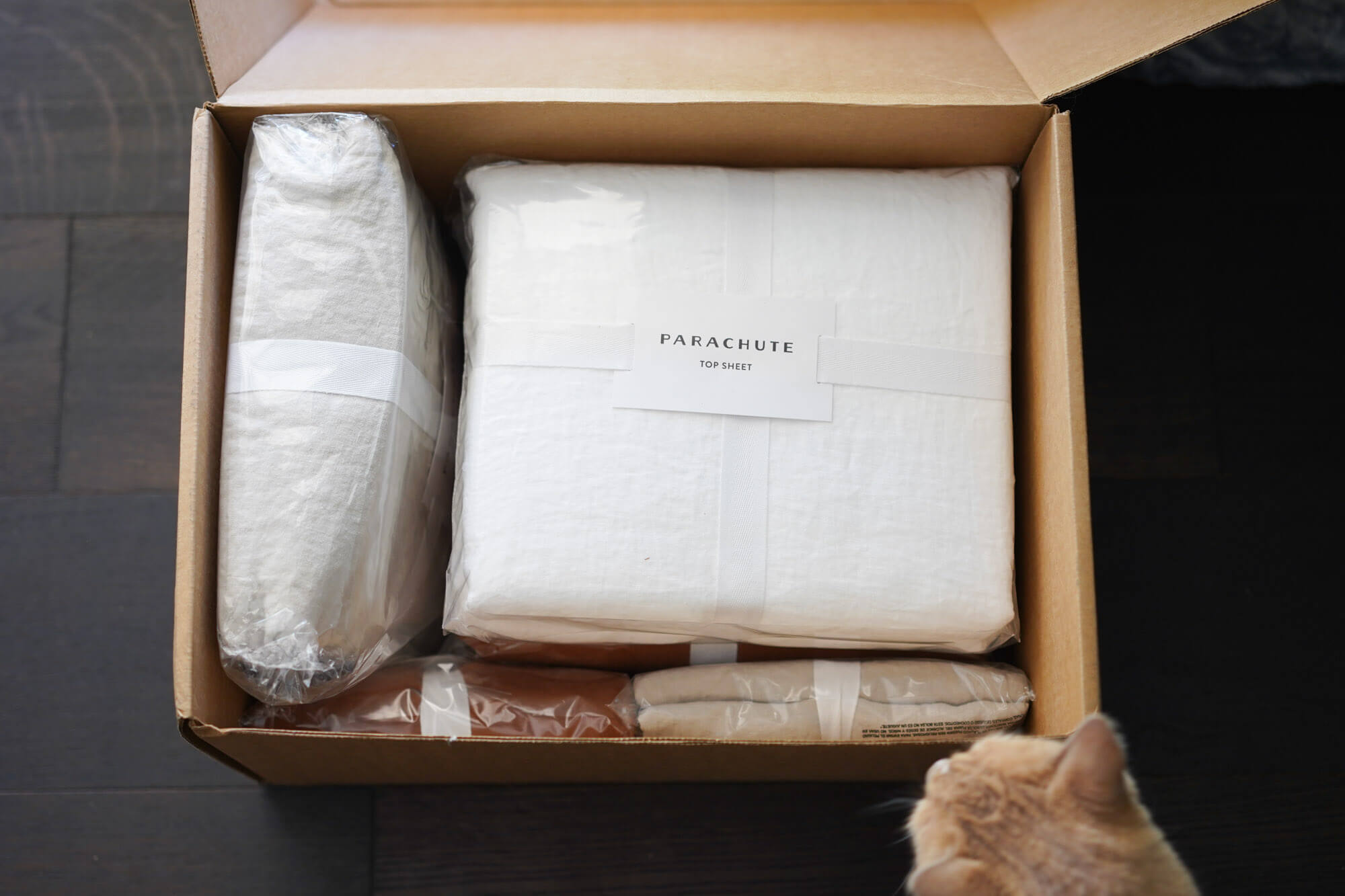
We chose Parachute because it’s a well-known brand for linen sheets. Based on recommendations from friends and family, it was a great starting point for testing linen sheets. Beyond this fact, we were also impressed by Parachute’s various options for linen sheets, colors options, and company transparency among other things.
Each of the linen items we tested is made from 100% European flax and Oeko-Tex Standard 100 certified, which means these products are made without the use of harmful chemicals and synthetics. All bedding is produced from a family-owned factory in Portugal that has been manufacturing fabrics like linen for generations.
The Parachute sheets we tested
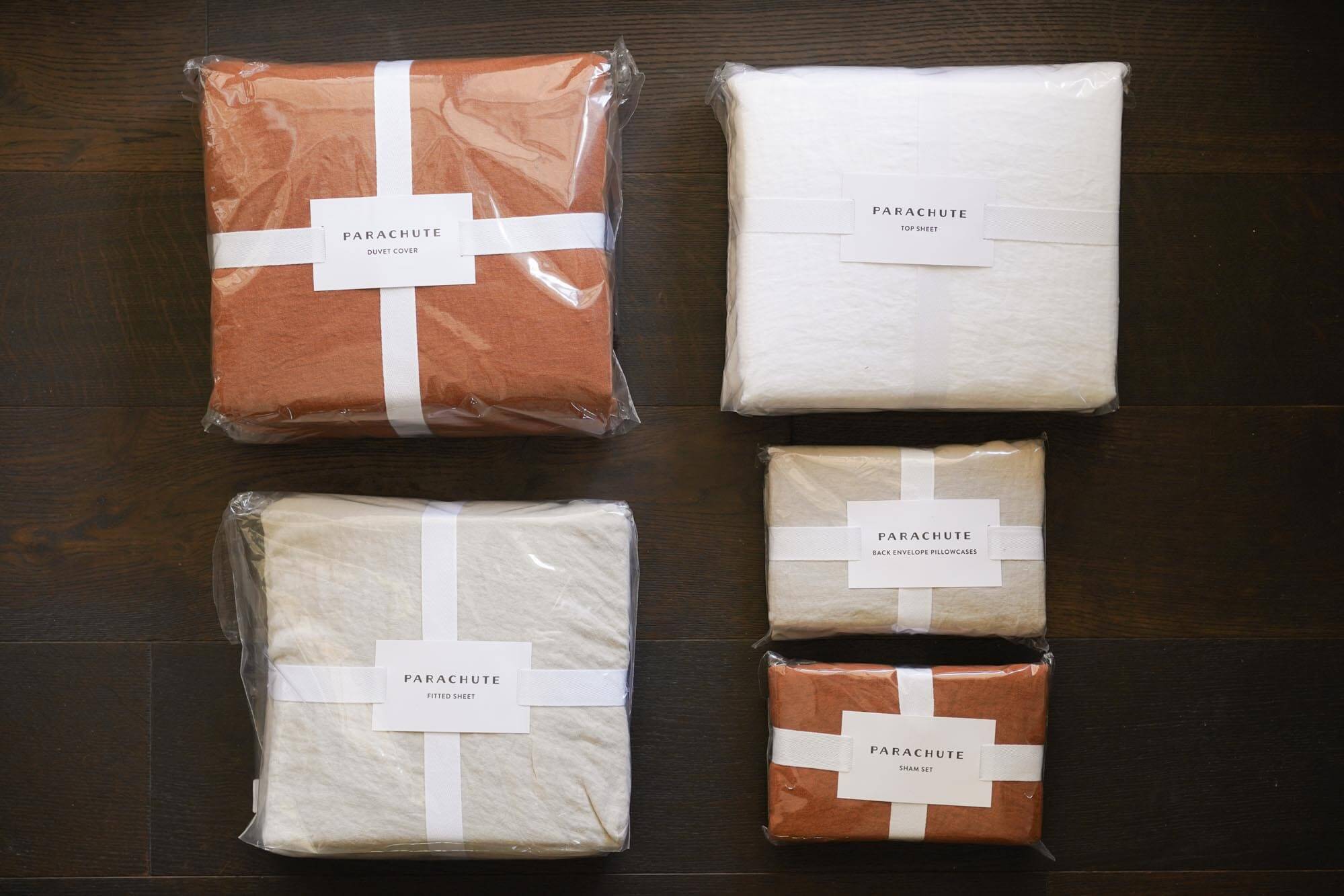
Since Parachute is best known for its linen bedding, we tested Parachute’s most popular linen bedding options:
- Linen Sheet Set: $149-$189 includes (1) fitted sheet & 2 pillowcases
- Linen Top Sheet: $90-$120 includes (1) top sheet (also known as a flat sheet)
- Linen Duvet Cover Set: $289-$359 includes (1) duvet cover & (2) sham pillowcases
All bundled sets come in one color, so if you want to mix and match colors, we recommend buying some items separately. While we could’ve added a top sheet to our linen sheet set, we chose to buy a separate top sheet to buy a different color. This worked out because adding a top sheet to your sheet set doesn’t technically save you money when bundling this together.
Percale vs linen vs sateen
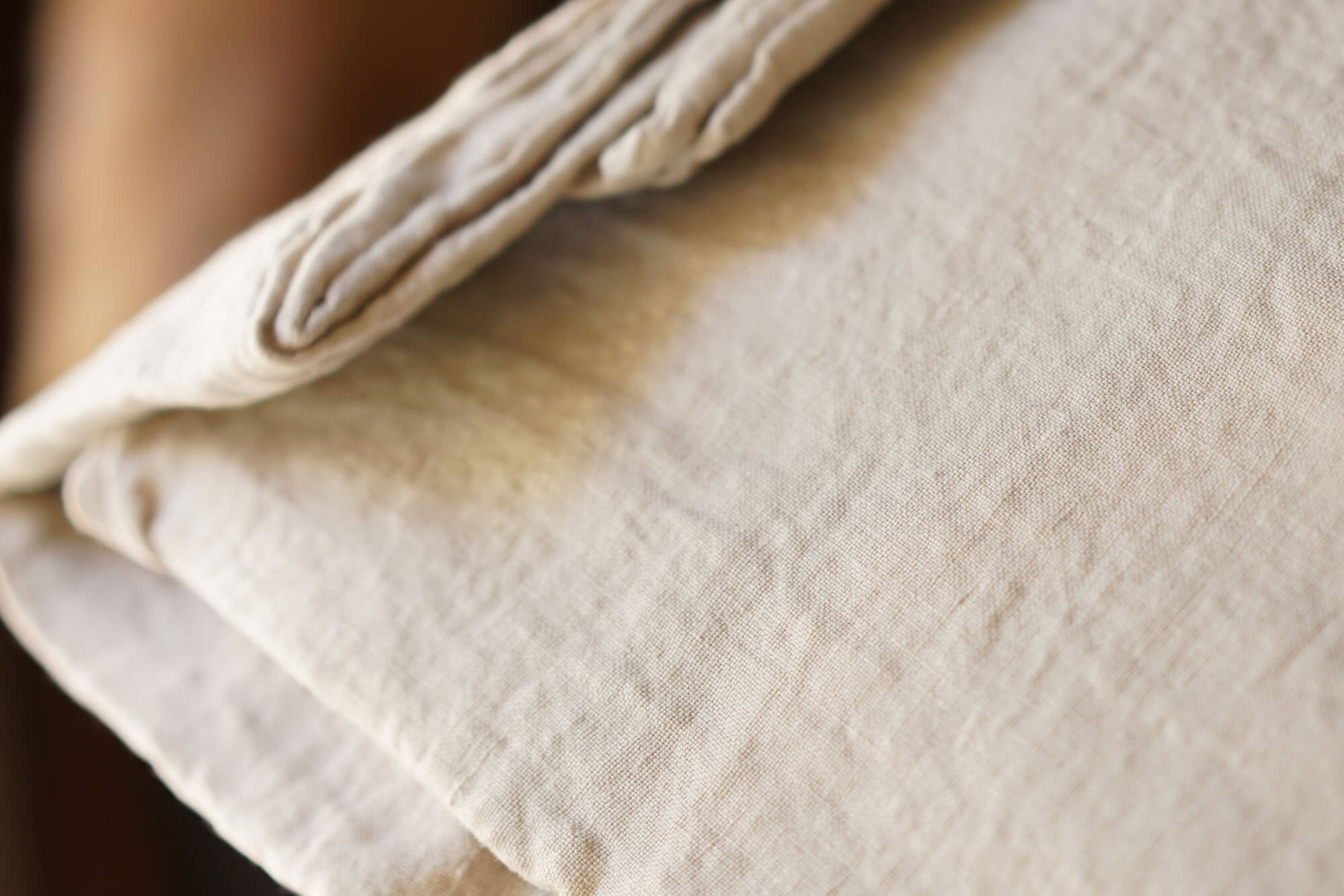
When you’re purchasing new sheets, it’s more than just colors and patterns to choose from, but materials and fabrics like percale, linen, and sateen. The type of fabric is one of the most important things to consider for your bedding especially since you will be spending a majority of your life lying on your sheets. Here’s a quick break of three of the most popular choices when buying new bedding:
Percale: These crisp and cool Parachute sheets are made of 100% Egyptian cotton and are best for use during hot summer months because they’re breathable and keep you cool. If you prefer sheets with a matte finish, then Parachute’s percale sheets are for you. Note that due to its 100% cotton material, it has a tendency to wrinkle faster than other bedding that is made up of a blend of materials or synthetic fabrics like sateen.
Sateen: If you prefer a satin-like, shiny finish to your sheets and are a cold sleeper, then sateen bedding from Parachute is for you. These sheets are also made with 100% long-staple Egyptian cotton but are less likely to wrinkle due to its finish and heavier weave.
Linen: This naturally durable fabric is breathable and perfect for those warm summer nights. Parachute linen is made from 100% European flax, which is known for its sustainability, hypo-allergenic, and antibacterial properties. This is a good choice for those warmer sleepers who appreciate a relaxed and rustic feel to their bedding.
Unlike other brands who list thread count on their websites, Parachute’s thread count is nowhere to be seen on their website. They state that the use of thread count is often used as a marketing scheme, especially those with higher-end thread counts past 400. Instead, they advise consumers to focus on the type of bedding they want, the fiber content, and fabric finish (and Oeko-Tex certification for clean fabric production).
How we tested
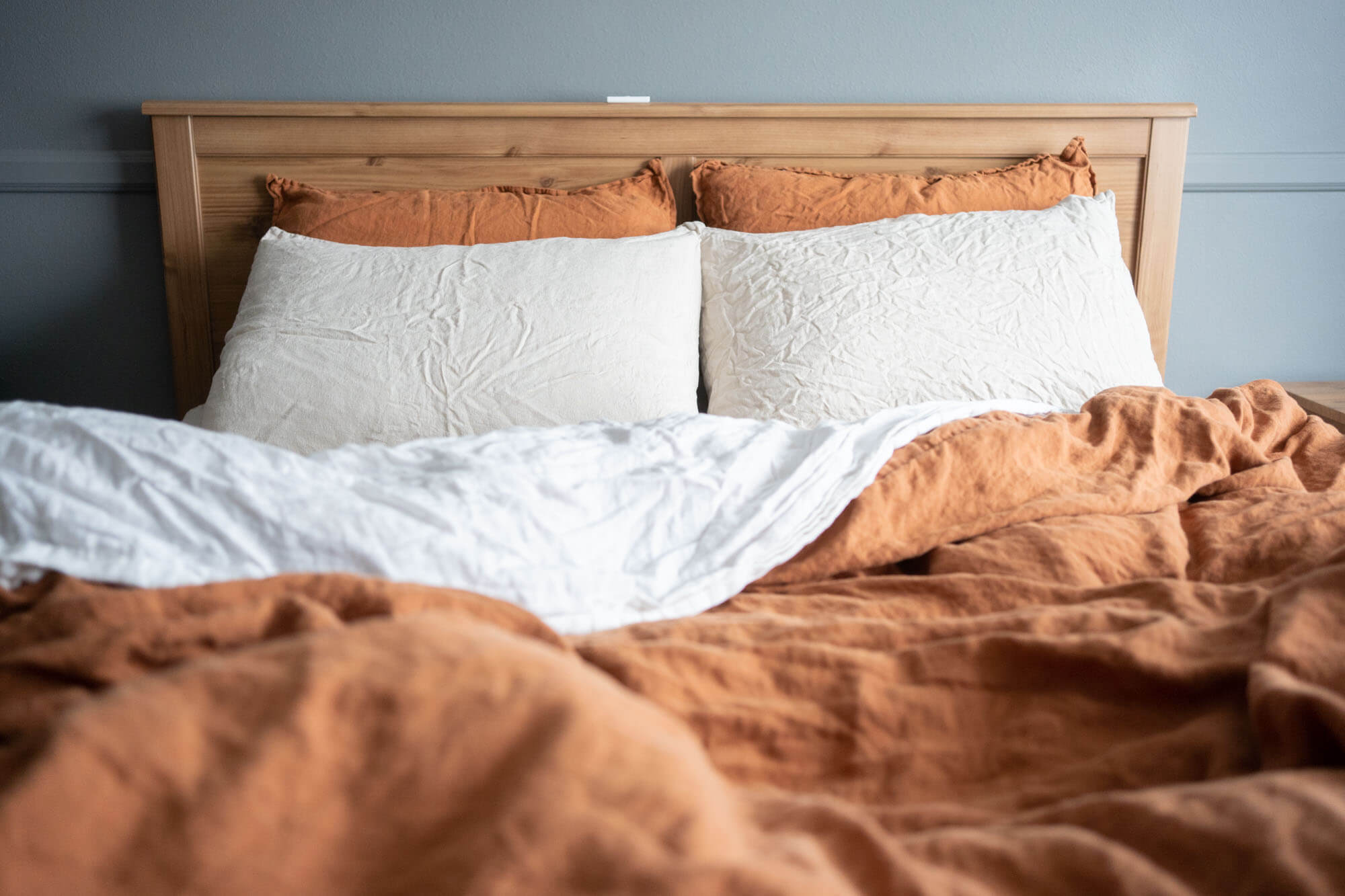
Size: We tested the Parachute linen bedding on a queen size, memory foam mattress and a queen size down comforter. We made sure to check the measurements before ordering the sheets and noticed a discrepancy between the sizing of the duvet cover and our down comforter.
We opted to go with a queen size in order to make sure it fit inside. One con is that the comforter can shift inside the duvet cover and get misaligned during the night. We often had to re-align the duvet cover daily to make sure it was evenly spread out. To prevent this shifting, Parachute includes straps inside each of the corners of the duvet cover to tie itself to the comforter, unfortunately, some comforters (like ours) did not have anything to tie the straps to.
Texture: Admittedly, we were a little hesitant to try out linen bedding because it’s also known to be more coarse in texture than traditional cotton sheets. Linen does have the ability to soften after a few washes, but this initial coarseness can sometimes feel scratchy against sensitive skin. However, we were pleasantly surprised to find that Parachute sheets were soft and pliant straight out of the packaging.
Parachute uses the process of garment dyeing each of its linen sheets after it’s woven to add various colors to their sheets, but this process also relaxes and softens the fabric. They are Oeko-Tex Standard 100 certified, meaning they don’t use harsh or toxic chemicals in producing their products. It’s still concerning how these processes that color and soften their linens may affect their durability throughout years of wear.
After months of sleeping on and washing the sheets and duvet cover, the linen material has significantly gotten softer with every use without causing pilling or breakage so far. Linen is known for its durability because it’s made of thick flax fibers–even with a cat sleeping and kneading on these sheets for months, it’s durable enough to keep from tearing.
Appearance: Linen itself is known for its rustic and relaxed aesthetic, so it’s important to remember that linen is easy to wrinkle even when it comes straight out of the dryer. After a few washes, these linen sheets crinkle easily along the edges and look a little disheveled compared to what they looked like coming out of the box.
Some reviews state that Parachute linen has a slightly heavier weight compared to other brands. The weight of these sheets along with their richly earthy colors give the linen bedding a luxurious, but relaxed look. We definitely prefer this effortless look to the bedding and it looks, even more, inviting at the end of a long day.
Temperature: For warm sleepers, linen is a perfect fabric to sleep in due to its breathability. Linen naturally wicks away moisture from your body and dries quickly due to the hollow flax fibers that make up the woven fabric. The linen Parachute sheets are no different and even allow us to use the duvet cover and comforter during warm summer months without getting too hot. Although in the winter, we foresee needing one more blanket for additional warmth.
Washing: We were surprised by the ease of washing the linen sheets once we read the instructions. Parachute recommends laundering their linen sheets in the washing machine using mild detergent and tumbling it dry on low. For those that want a neater look, you can also use an iron on low to smooth out the wrinkles but we prefer the rough and tumbled look.
After months of using the washing machine on these sheets, they’ve gotten significantly softer with every wash and have not caused pilling in any of the items. However, we have noticed that there is a lot of leftover lint in the dryer after each washing. This has not currently shown any wear on the linens themselves.
Parachute vs Brooklinen vs Boll and Branch
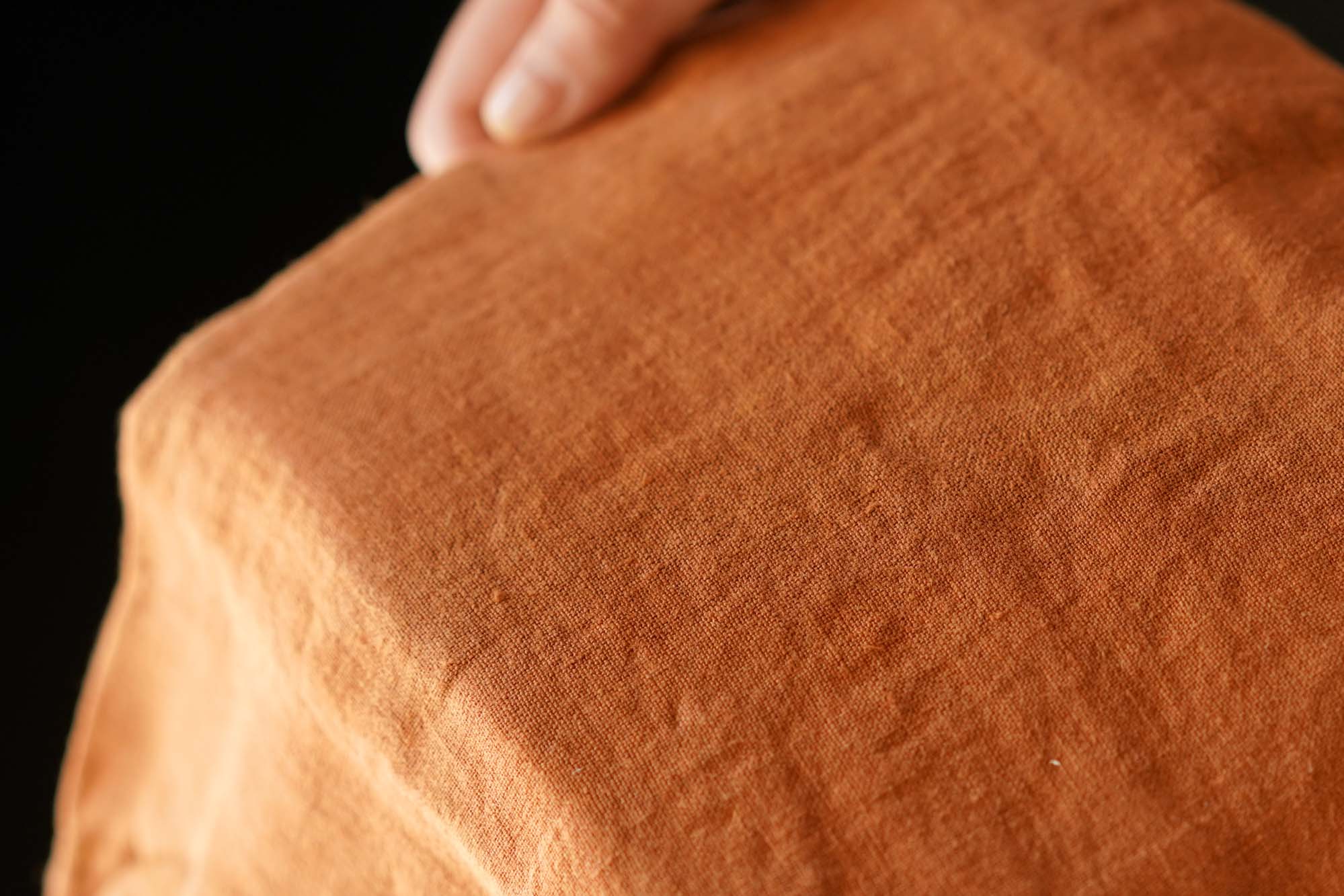
There are numerous linen bedding brands that are in the market right now. Parachute, Brooklinen, and Boll and Branch are all popular brands that are comparable in price, focus on sustainability, and millennial audience.
Based on their prices, each of these brands are relatively close in price, with Brooklinen being the most affordable and Boll and Branch being slightly more expensive than Parachute. Where each differs is their designs; There’s an aesthetic for anyone.
Here’s a quick breakdown of each company:
| Parachute | Brooklinen | Boll & Branch | |
|---|---|---|---|
| Price for Queen set (1 fitted, 1 flat top, 2 pillowcases) | $279 (with added flat top sheet) | $242 | $298 |
| Bundle includes: | 1 fitted sheet 2 pillowcases (option to add a top sheet) | 1 fitted sheet 1 flat sheet 2 pillowcases | 1 fitted sheet 1 flat sheet 2 pillowcases |
| Material | 100% Linen, made from European Flax | 100% Linen, made from European Flax | 100% Linen, made from European Flax |
| Certifications | Oeko-Tex Standard 100 certified | Oeko-Tex Standard 100 certified | Fair trade Oeko-Tex Standard 100 certified |
| Color availability | Many earthy neutrals | Bright colors & patterns | Low options, mostly blue hues |
| Return policy | Within 60 days | Within 365 days (with a $9.95 processing fee) | Within 30 days |
Parachute’s return policy
If you find that Parachute’s sheets aren’t to your liking, they also allow returns within 60 days of delivery in the original method of payment–all shipping and handling fees are nonrefundable so keep this in mind when purchasing products. The only items that aren’t up for a refund are final sale items, furniture, and other items listed on their website. Make sure to read all the details about each item before purchasing.
What’s great about returning a product is that you don’t have to feel bad about wasted items either. Parachute donates all usable bedding items to their partners at Habitat for Humanity of Greater Los Angeles and Habitat for Humanity of Berks County.
The bottom line
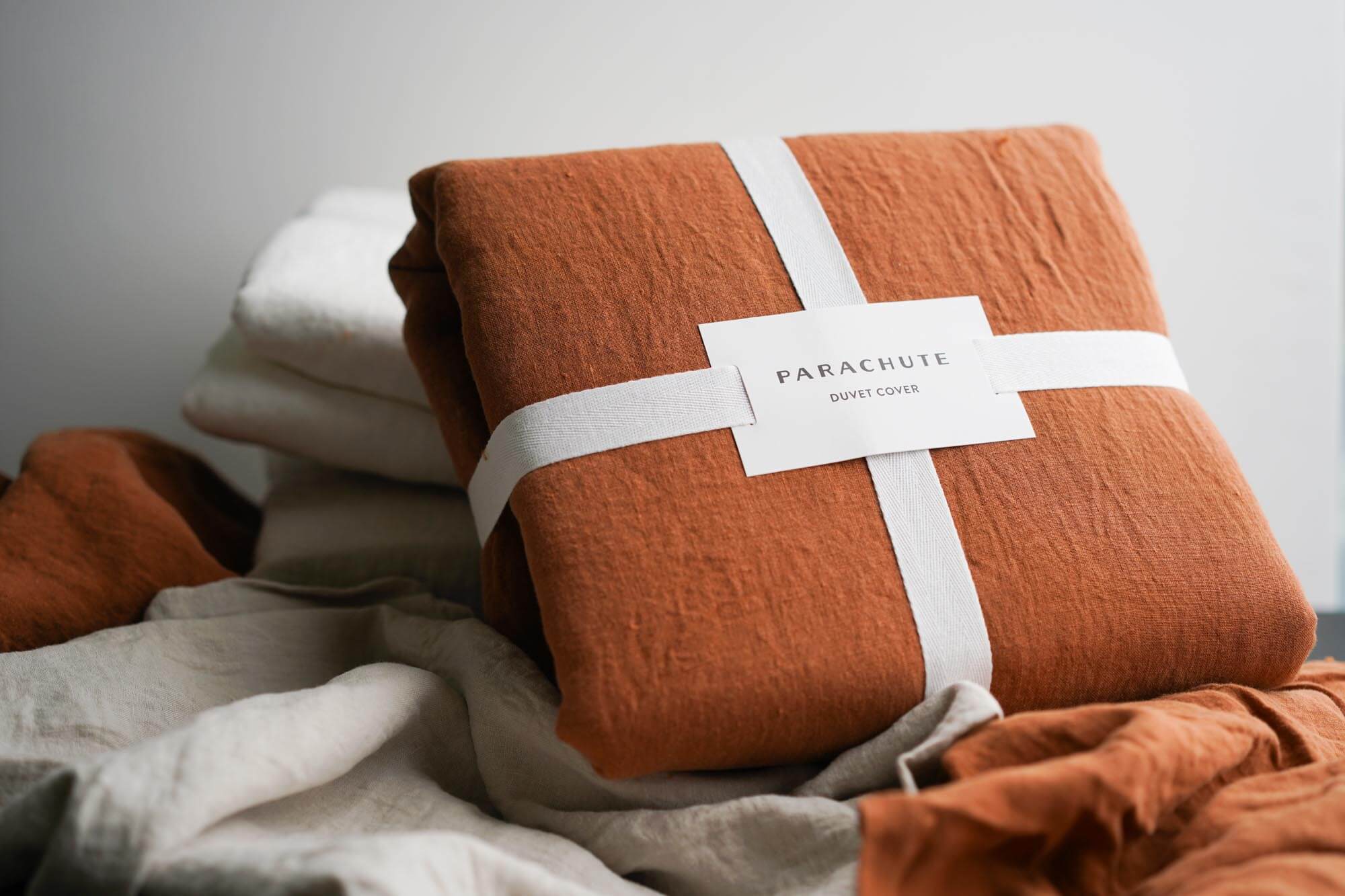
If you find the price range to be a little high, Parachute does hold sales twice a year during Memorial Day and Black Friday where you can save about 20% off or more on their linen beddings products.
Coming from basic discount sheets found at your local department store, Parachute linen sheets definitely felt luxurious and induced many relaxing nights. If you want an upgrade from your everyday cotton sheets, but enjoy a relaxed and super soft bedding (and are willing to put up a little extra cash for these sheets), then we would definitely recommend Parachute linen bedding.
The post Parachute Sheets & Bedding Review appeared first on Your Best Digs.
]]>The post Levoit LV-H132 Air Purifier Review appeared first on Your Best Digs.
]]>Table of contents
- What can air purifiers do?
- Testing the Levoit
- Compared to other air purifiers
- Cost of Levoit air purifier filters
- The bottom line
What can air purifiers do?
The High Efficiency Particulate Air (HEPA) filter standard means a filter can capture 99.97% of the tiny, most-difficult-to-trap particles in the air — tiny means 0.3 microns in diameter, the size of some virus and bacteria bodies. Note that performance with bigger or smaller particles is even better.
But even with that amazing capture rate, if the air purifier fan doesn’t move all the air in your room through the filter a few times per hour, even dust coming in through windows and doors may be more than the purifier can keep up with.
If you’re making a lot of dust or smoke inside, ventilation or more effective cleaning will make a much bigger difference than filtering the air. Check out our full review for a list of steps you should take before you resort to an air purifier.
What about the coronavirus?
When we researched our review of the best air purifiers, we asked experts at the California Air Resources Board if the 99.97% capture rate of a HEPA filter is enough to protect against virus exposure.
Jeffery Williams, from the Indoor Exposure Assessment team, sums up the science: “There’s really no clean-cut answer. The tests for these devices are using a very contrived scenario when they’re quantifying efficiencies. Specific dust sizes are generated and then the amount of dust before and after the filter is measured and you get an efficiency. In the natural world, you’ve got a very broad range of particles; some bacteria and viruses are large enough to get captured, some aren’t.”
If you want to take the precaution of filtering your air, remember that air purifiers are only effective at removing particles that are floating through your room — they can’t do anything about a virus body trapped behind a closed door or stuck to surfaces.
The good news is that a virus like SARS-CoV-2 is killed easily with soap and water, or a 60–70% alcohol solution in hand sanitizer if you don’t have access to a sink.
Testing the Levoit
The differences between air purifier models come down to three questions: how big of a room can it clean, how loud is it, and how much will it cost to run?
The Association of Home Appliance Manufacturers (“AHAM”) with their Verifide program have developed a standard to answer the first question. They test air purifiers with three categories of air pollution: large dust particles, pollen-size particles and smoke-sized particles. The result is certified as a “clean air delivery rate” (CADR) — the cubic feet of air per minute an air purifier can clean. (Multiply the CADR number by 1.66, and you’ve got an estimate for square footage the purifier can handle.)
We mostly purchased air purifiers that are already certified this way, but a few top-selling models like the Levoit weren’t. Levoit gives their own specification for how big a room the machine is supposed to be suitable for, so we set up a controlled test to get a fair comparison.
We sealed off a test chamber (equivalent to a very small 68-square-foot room) with a plastic barrier and introduced controlled amounts of dust and tobacco smoke, then recorded the falling number of ultra-fine half-micron particles detected by a laser-powered Dylos particle counter.
We ran tests with each air purifier on both high and low speed settings to see how much performance you’re giving up in order to turn down the noise. Along with the performance tests, we also checked noise output of each model and checked power draw at different fan settings.
Levoit performance results
The chart above is a comparison between the Levoit – LV-H132 and the GermGuardian – AC4825. They retail for about the same price and have similar performance claims in their advertising. The biggest difference is that the GermGuardian has been tested and certified to deliver 108 CFM (cubic feet per minute) of clean air when filtering smoke. (We tested one more certified CADR-100 air purifier, and its performance was similar to the GermGuardian.) If you believe the advertising, these machines should be able to clean the air in a room double the size we were testing in.
The Levoit took 10 minutes longer to clean half of the thick cloud of dust particles out of a small room, and after 40 minutes at top speed it still didn’t take out as much as the competitors on their lowest speed settings.
Levoit used to simply claim that this air purifier was suitable for rooms up to 129 square feet. They’ve since updated their marketing to include a theoretical CADR of 40 cubic feet per minute, which means you’d filter the air in a room that size just more than twice per hour. With dust coming in the door or a person moving around, you could easily have more dust coming into the room and swirling around than the Levoit can keep up with.
If you leave the Levoit running for long enough, it can probably capture all of the dust from some small rooms. If your outside air quality is good enough (or your room is sealed tightly enough) that you’re not worried about outside dust coming in through the doors and windows, you probably don’t need an air purifier at all.
If you’re making dust and smoke inside from moving around, cooking and cleaning, we recommend a bigger air purifier that can actually make a noticeable difference quickly.
Compared to other air purifiers
| Air Purifiers | Price | Suggested Room Size (sq. ft.) | Annual Cost (power + filters) | Noise Level (high setting) | Auto speed control? |
|---|---|---|---|---|---|
| Larger Models | |||||
| 1. Winix - 5300-2 | $$$$ | 360 (AHAM tested) | $61 | 62 dBA | Yes |
| 2. Coway - AP-1512HH | $$$$$ | 361 (AHAM tested) | $65 | 62 dBA | Yes |
| 3. Honeywell - HPA200 | $$$$ | 310 (AHAM tested) | $104 | 60 dBA | No |
| Smaller Models | |||||
| 4. GermGuardian - AC4825 | $$ | 155 (mfr. tested) | $107 | 56 dBA | No |
| 5. Honeywell - HPA100 | $$$ | 155 (AHAM tested) | $76 | 59 dBA | No |
| 6. Levoit - LV-H132 | $$ | 100 (mfr. tested) | $42 | 48 dBA | No |
The bigger Winix 5300-2 is our pick for households that actually need an air purifier, because it only costs $50 more than the Levoit, but it moves about five times more air — a CADR of 232 vs. 40. Winix also includes an air quality sensor and a timer. The main downside to the Winix is that it’s a larger machine, almost as big as a carry-on-size rolling suitcase. It also doesn’t let you turn off the light when the fan is running at full speed the way the Levoit does.
If you need a smaller air purifier, we liked the GermGuardian – AC4825 better than other compact models. It’s not much quieter or less expensive than the Winix, and it draws more power to do the same job, but it will fit more easily in the corner of a small bedroom.
Cost of Levoit air purifier filters
If you’re wondering about the overall cost of maintenance, the LV-H132-RF Levoit air purifier filter is very affordable at about $13 per replacement. If you calculate cost based on the manufacturer’s recommended schedule, with a new filter every 6 months, you would spend about the same on filters as you do for a bigger air purifier like the Winix.
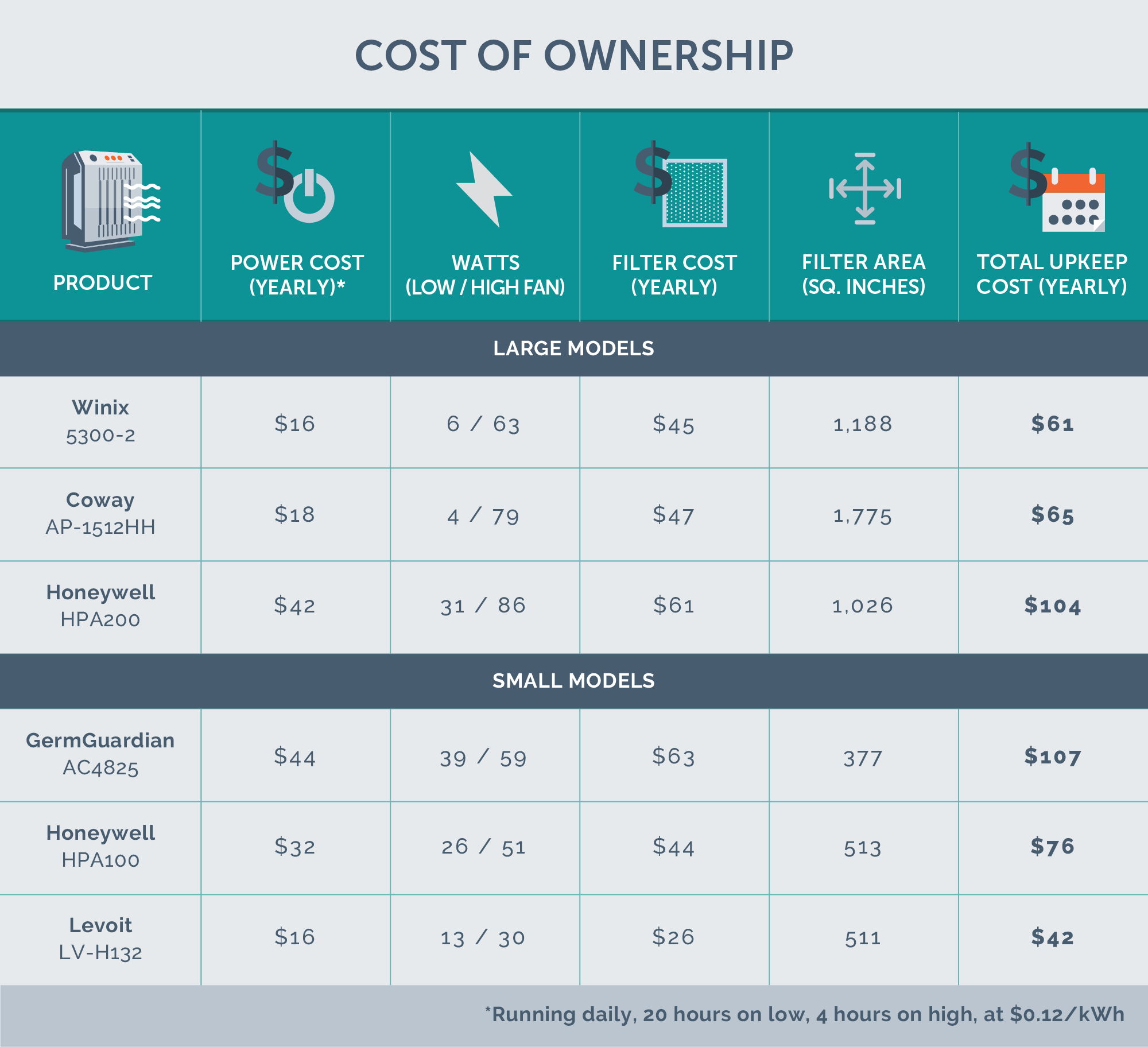
It’s important to note, however, that HEPA filters will work for a very long time before they get plugged with household dust. Levoit made their filter quite a bit bigger than it needs to be for the airflow capacity of the machine, so many households can count on it lasting a year or more.
Our Winix filter has lost about 10% efficiency over two years of regular use in a small household. Typically these filters lose some of their ability to attract ultra-fine dust first, then slowly plug up with larger dust and start to restrict airflow. If you’re really giving an air purifier a workout with dusty conditions, smoke, cooking oil and pet hair, it’s wise to stick to the annual replacement schedule.
The bottom line

If you need an air purifier the size of a box of tissues, this is technically a product that will clean your air. The housing and controls are designed well, and you can turn off the blue light if you run it after dark.
But on all the points that matter most — speed to clean your air, efficiency and noise — the Levoit is beaten easily by bigger air purifiers turned to their just-as-quiet speed settings. The small fan inside this machine is simply not moving enough air to keep up with the competition.
The post Levoit LV-H132 Air Purifier Review appeared first on Your Best Digs.
]]>The post The Best Books for Men appeared first on Your Best Digs.
]]>How we selected these books
Don’t think of this as a list of books that are only good for men — in most cases, the stories and information they contain will appeal to everyone. We’re assuming that you’re reading this list either because you’re a man who’s run out of ideas for what to read next, or you’re someone trying to encourage a man to read more by picking up a book for him. If you are looking for a gift, the best book light makes an excellent pairing.
We’ve had people making lists of books for almost as long as we’ve had books. The invention of the printing press means that nearly anyone can publish a book; that means there are dozens of books written by somebody, somewhere you’d love to read that you’ll never even know about. From lists of banned books to bibliographies of niche topics compiled by academics, book lists have always been a way for people interested in specific ideas to tell readers how to find (or avoid) relevant books.
As we put together this list, some of the readers we surveyed insisted that since male authors and readers have dominated the publishing sphere throughout history, the idea of a specific set of books for men is redundant and silly, if not offensive.
Nobody is saying that men and women can’t read the same books. But just as there are specific topics that interest women in general — or enough women to keep the publishing industry looking for new ways to tap into that market, anyhow — we’ve found that there are specific topics that most men are interested in. Remember too that a “best book” list pretty much has to be controversial — Michael Caines of the Times Literary Supplement calls book lists “one of the oldest and dodgiest forms of literary criticism.”
We surveyed 25 men who are avid readers, many of whom take part in regular book-club discussions. We also surveyed lists from magazines and websites that focus on stories for men. We studied the reader-generated lists on the Goodreads network, a website that helps people find and review books.
After surveying these other lists of books and looking for common threads, we identified a few themes or features of the books that the men in our survey thought were most important:
- Insight: Learning what’s going on behind the scenes, how things work, and how to strategize. This kind of insight is important in biographies of powerful leaders, but dramatic depictions of relationships can also provide much-needed food for thought.
- Adventure: Similar to the epic journeys of classic myth, but with more character development and gritty detail.
- Coming of age: How to pass on or inherit a legacy (be it elevating or burdensome) is a weighty question for many modern men.
- Survival: In both fiction and non-fiction titles, situations where the outcome is uncertain and the stakes are life-or-death.
Our list
After we compiled a list of over fifty candidate books to include, we narrowed that list to a group of thirty-six finalists. After that, our researcher used surveys to rank the fifteen best books for men.
The post The Best Books for Men appeared first on Your Best Digs.
]]>The post The Best Reading Lamps appeared first on Your Best Digs.
]]>Table of contents
- Compare the best reading lamps
- 1. Best reading lamp for desks Ominilight
- 2. Best reading lamp for bedsides Newhouse Lighting
- 3. Best reading floor lamp Newhouse Lighting
- Other finalists we tested
- How we selected finalists to test
- How we tested
- What makes a good reading lamp?
- Important features to consider
- The bottom line
Compare the best reading lamps
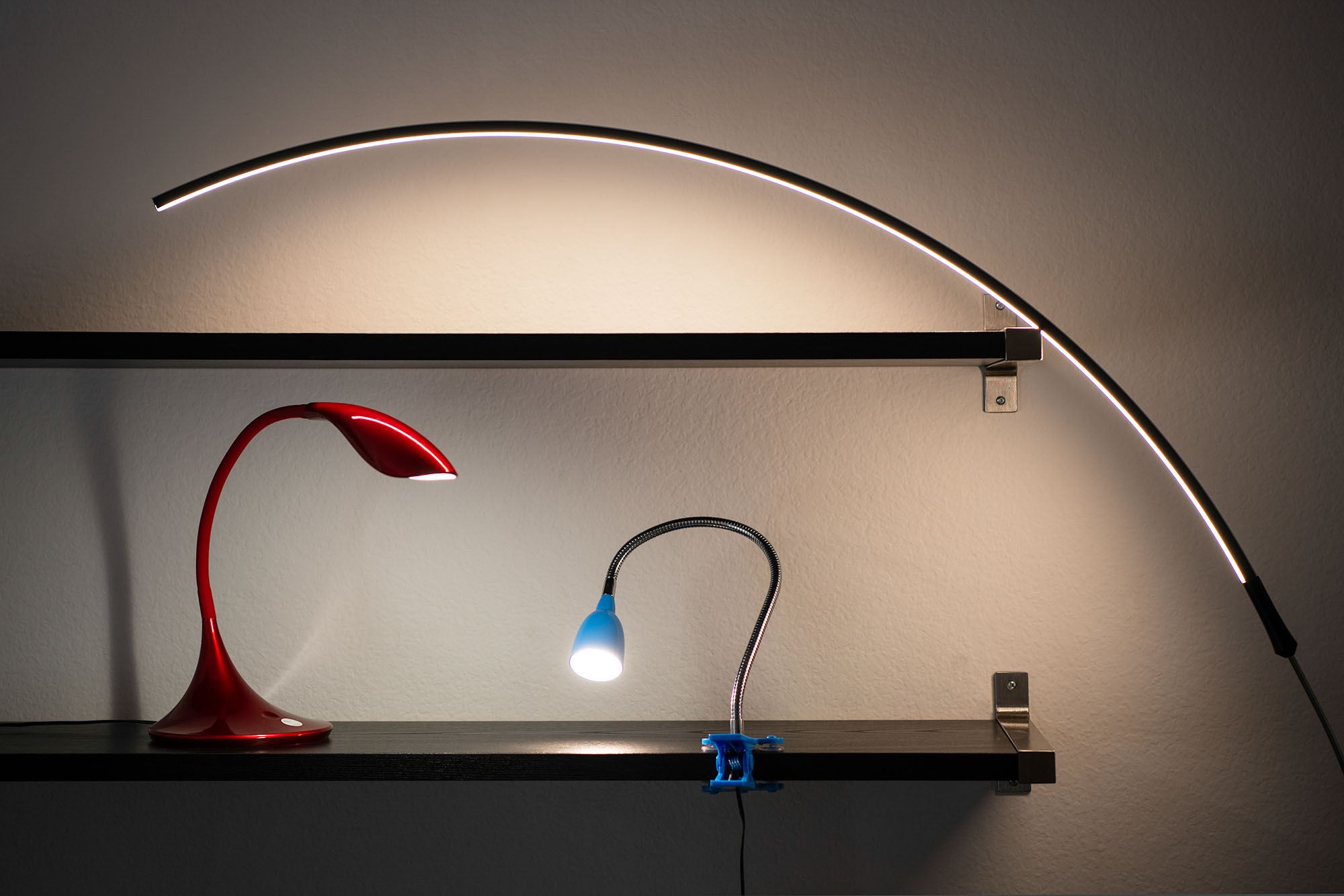
| Product | Price | Type | Lumens (Brightness) | Kelvin (Color Temperature) |
|---|---|---|---|---|
| 1. Omnilight | $$$ | Desk | 405 | 6500 |
| 2. Newhouse Lighting | $ | Clip-on | 350 | 3000 |
| 3. Brightech - Sparq | $$$$ | Floor | 2000 | 3000 |
| 4. Tomons - Swing Arm | $$ | Desk | 800 | 3300 |
| 5. KEDSUM | $ | Clip-on | 225 | 3000-6500 |
| 6. Brightech - Lightspan | $$$ | Floor | 2000 | 6000 |
1. Best reading lamp for desks
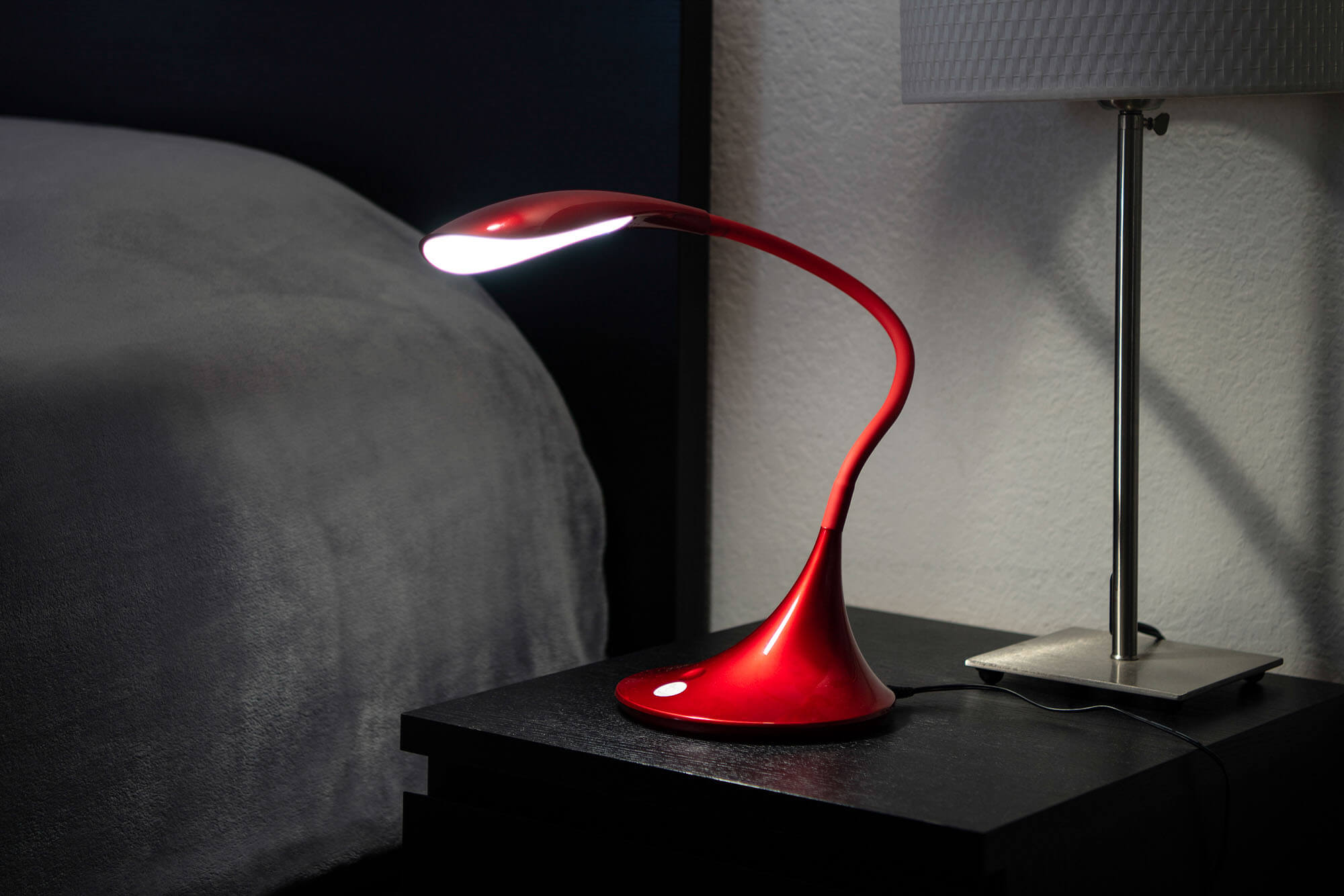
Our testers loved the sleek and shiny Ominilight – Desk Lamp, in no small part thanks to its one-touch control: A fingerprint-sized groove in its base helps you easily find the control even in the dark. The Ominilight has three different brightness settings that could cater to different needs. The lowest setting gives enough light for you to read without bothering someone beside you. The brightest setting was quite bright but still gentle on the eyes.
The Omnilight’s color temperature is a little cooler at 6,500 kelvins, meaning that it’s better for stimulating the brain than for reading right before bed, making it better-suited as a desk lamp.
Another great feature of Ominilight is its curved head, specifically designed to allow the light to reach further without causing any harsh shadows. The gooseneck feature makes it easy to point the light to any particular area of a desk. The Omnilight is an excellent choice for someone looking for a modern-style bedside or table lamp.
Key takeaways:
- Touch control on the base makes controlling the lamp a breeze.
- Brightness is adjustable with three adjustments.
- The curved head makes this lamp easy on the eyes.
2. Best reading lamp for bedsides
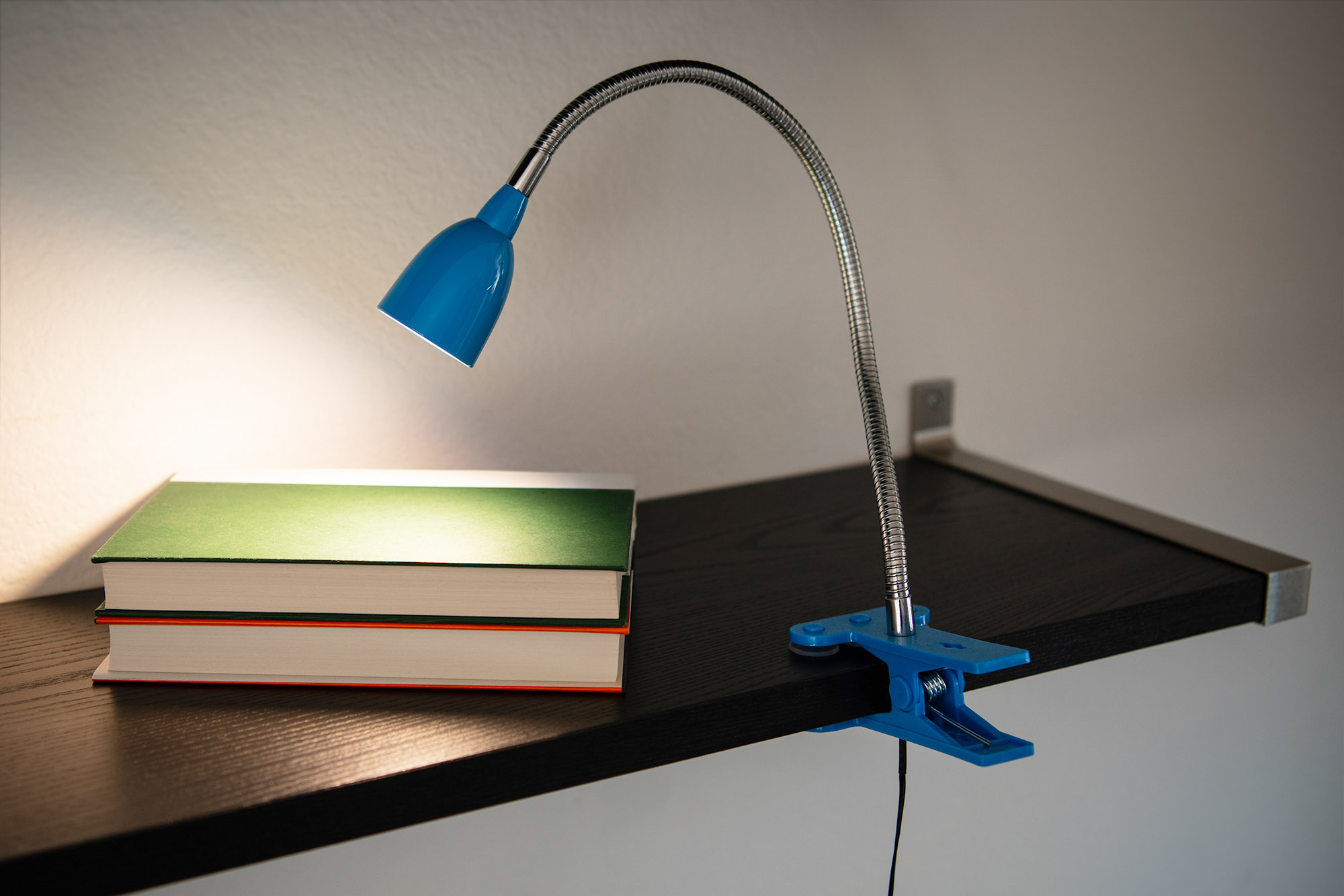
The Newhouse Lighting – Clip On is a 350 lumens clip-on light that’s great for brightening up a page with its warm 3000K LED light. It has a 6-foot cord and a clip that can grip a surface up to three inches wide, which performed best when we clipped it to the edge of a desk or nightstand.
The Newhouse had a few standout features, including an exceptionally flexible metal gooseneck, a simple and easy to use switch and a strong clip complete with six suction cups for extra stability on a glass surface. While the plastic clip’s strength may make the Newhouse lamp extra stable, we needed to exert some effort in clipping and unclipping it.
Overall, the Newhouse reading lamp is a great option for someone who prefers a small lamp that can be moved around to suit their needs, whether they are reading at a desk or in a bed.
Key takeaways:
- The Newhouse’s 6-foot cord gives it an especially long reach.
- Small and compact, the Newhouse lamp is a great space saver.
- With a strong clip and and flexible metal gooseneck, the Newhouse stays exactly where you put it.
3. Best reading floor lamp
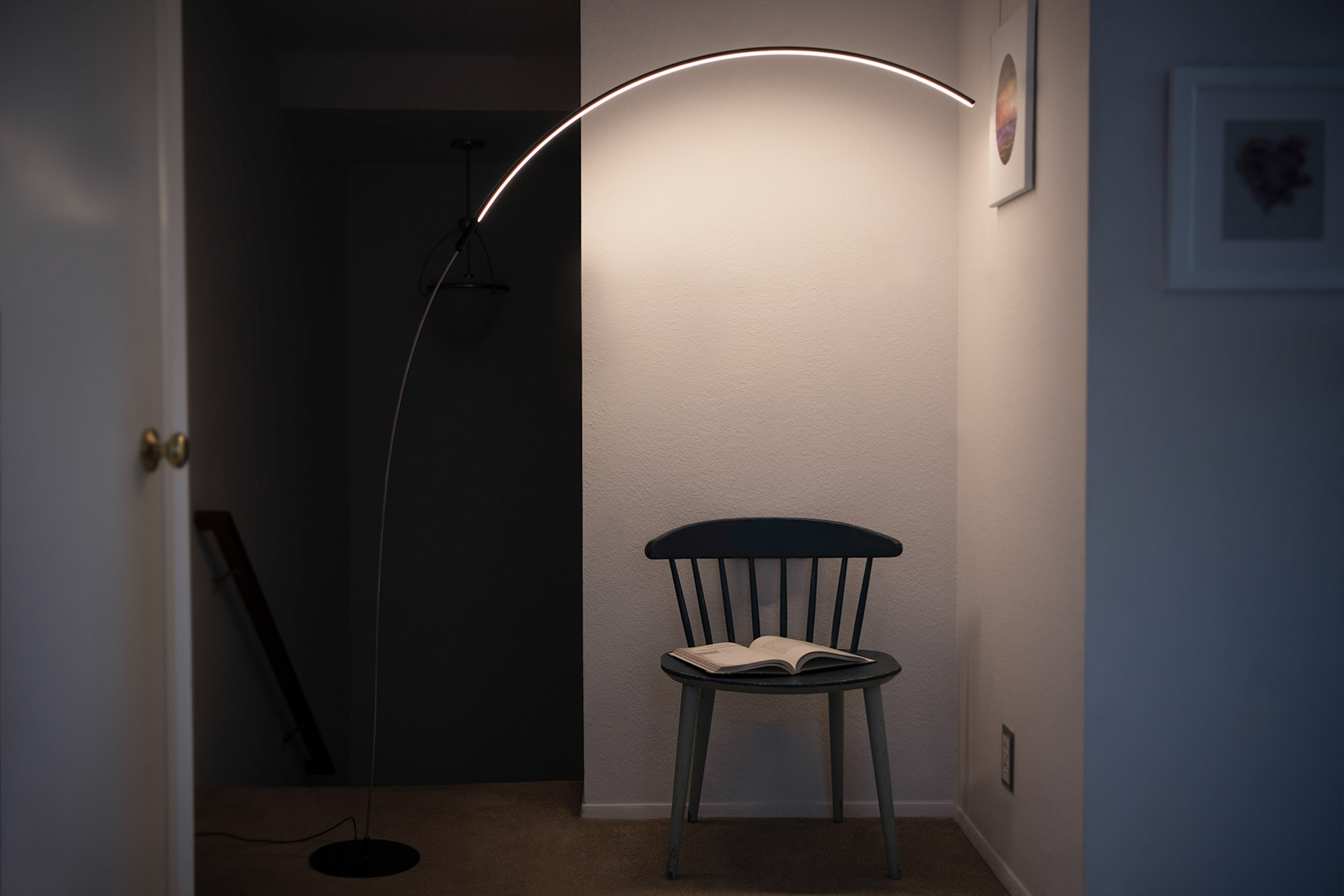
The Brightech – Sparq is a unique arcing lamp that makes a big impact. Its minimalist design provides a surprising amount of coverage by throwing light from the side and overhead, thus diminishing shadows. Because of this feature, the Sparq could easily double as an efficient task and accent light.
Another great feature is the foot button. While our testers thought it performed well placed near a couch, bean bag chair, or bed, they preferred it placed near a desk where its three brightness settings could be adjusted with a simple tap of the foot. The Sparq’s light is gentle on the eyes and made a substantial difference in lighting our testers’ desk.
Key takeaways:
- Arcing light source provides lighting from above and from the side for shadowless illumination.
- The floor button makes it easy to adjust the brightness between three settings.
- Lightweight and sleek, the Brightech Sparq can be easily moved or turned.
Other finalists we tested
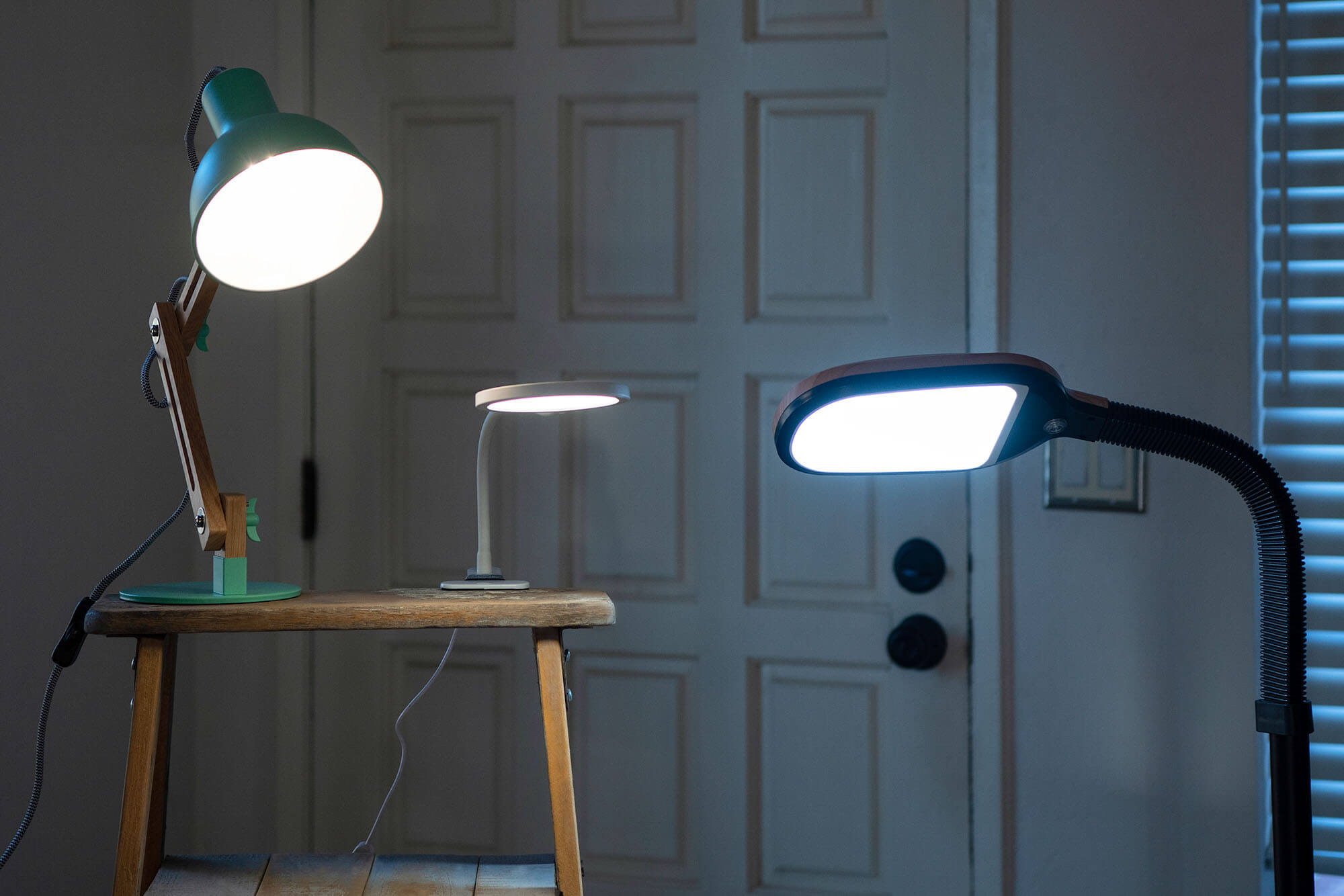
Tomons – Swing Arm Desk Lamp
Aesthetically, the Tomons – Swing Arm Desk Lamp is somewhat reminiscent of the Pixar logo. It consists of a base, three different joints and an opaque hood. This is actually the only lamp on our list with an exposed bulb. While adjustable up and down, compared to our gooseneck lamps, the Tomons desk lamp has much less range of motion.
The power switch is located on the cable (which can’t be concealed) and produces a clicking noise when switched on or off. The lighting is pleasant, easy on the eyes, and the LED bulb doesn’t heat up. This is a tasteful, pleasant lamp and while it didn’t get our top pick, this is a lamp for a person who wants something straightforward and trendy.
KEDSUM – Clip On Lamp
The KEDSUM – Clip On Lamp, powered by USB, has a whopping 11 settings on its dimmer control. We were inclined, however, to use the brighter settings and found the other settings excessive. Like the Newhouse, the KEDSUN has a flexible gooseneck, and though it shook slightly during testing, it stayed secure, thanks to its sturdy metal clip.
The KEDSUM has nicely diffused and even lighting, and although it didn’t make our top pick for a clip-on reading lamp, its adjustable features makes it a good space-saving choice for a reader looking for versatility in a reading lamp.
Brightech – Litespan
The Brightech – Litespan stands a little over 5-feet tall and has an adjustable upper half. Its light is daylight bright, which our tester felt was too harsh. Our consensus on this lamp is that with its 6,000K natural-daylight spectrum white light and 2,000 lumens output, it would be better as an office or shop light rather than a reading light.
How we selected finalists to test
We consulted reviews online, searched through Reddit for considerations when buying reading lamps and discussions on LED lighting, and referred to some of the same concerns addressed in our review of the best book light. We also spoke with Arthur Smith, editor of LEDwatcher.com, about what we should be looking for in a reading lamp. We narrowed down our choices to include two floor lamps, two desk lamps and two clip-on lamps.
How we tested
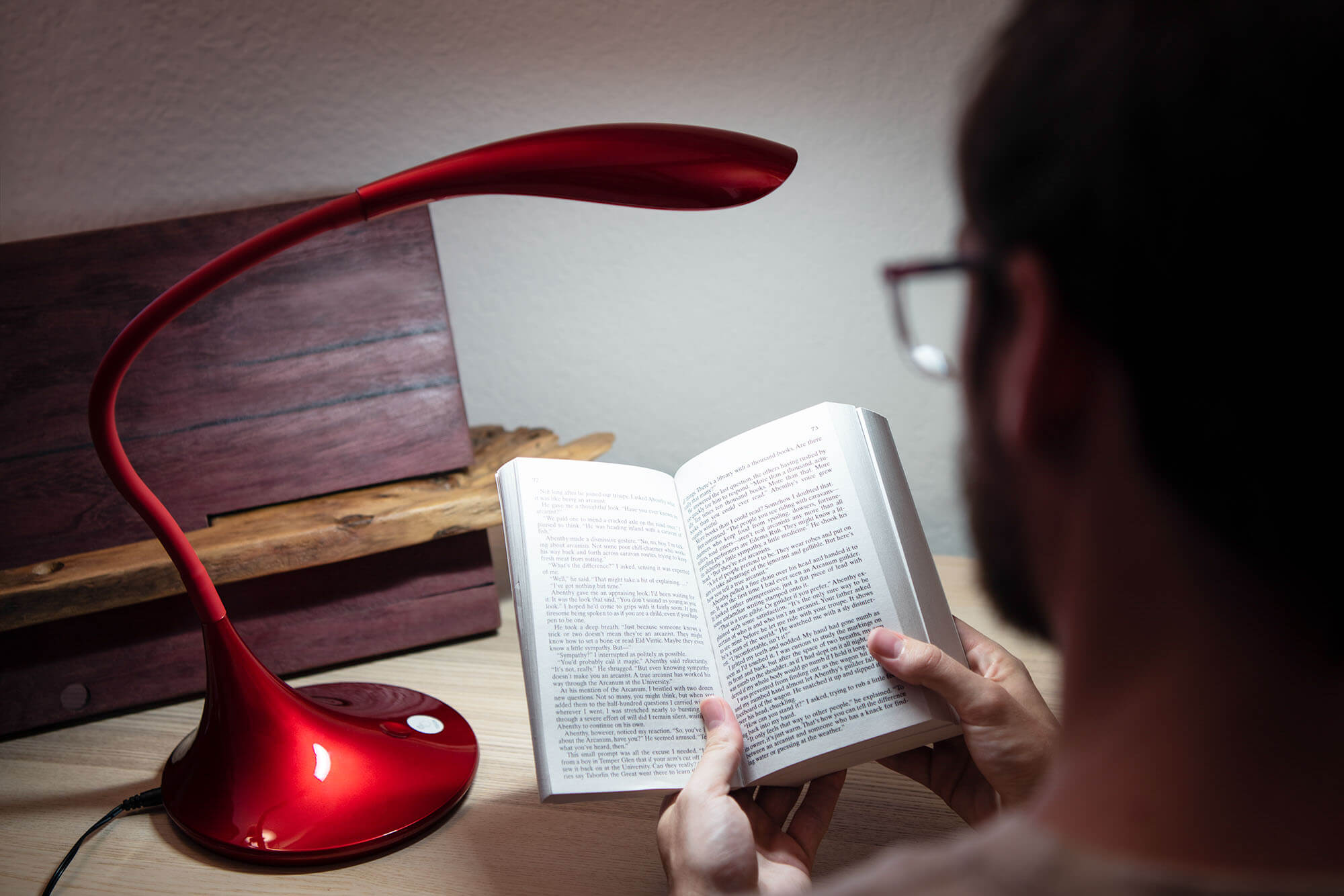
After assembling our six reading lamps, we carefully inspected and noted their features. This included measuring cords, testing switches, bending flexible parts and generally assessing the quality of materials.
Over a two-week period, our group of participants tested the lamps for at least 30 minutes a night and responded to questions we provided them. Using these questionnaires, and combined with our initial inspection of each lamp, we determined the winners for three categories: best reading lamp for desks, best bedside reading lamp and best floor reading lamp.
What makes a good reading lamp?
There are three basic types of lighting:
General: Provides an even distribution of light to a room
Accent: Shines light to draw attention to a particular area of a room
Task: Lights a smaller area where a “task,” such as reading, occurs
Reading lamps fall under the category of task lighting. Because reading lamps are physically much closer to the task at hand (in our case, books), they keep an area brightly lit to protect readers from straining their eyes in dimmer conditions.
As Arthur Smith told us: “Reading in dim light will make your eyes tired more quickly, which often results in eye strain, dry eyes, blurred vision and even headaches.” The best reading lamp, he emphasized, will be the reading lamp you actually use.
When looking to make the purchase, consider your habits. Do you usually read in bed, on the couch or at a desk? Do you need a light that can move around with you?
Important features to consider
Styles: Depending on the location of where you normally like to read and what kind of aesthetic you like, you’ll be able to better pinpoint what works for you. Some lights have flexible goosenecks that allow readers to point the light in many possible directions. Other lights have clips that can grab onto a headboard. Preferences for switches or buttons, metal or plastic, or even the length of the cord are just some of the many options.
Brightness: Brightness in LED lights is measured in lumens. More mature eyes will generally need more lumens. Children can handle lower lumens around 450, adolescents and adults do well with 800 to 1100 lumens, and seniors need about 1600 lumens. Some lamps conveniently have adjustment controls for the reader to change the brightness to a range that better suits them.
Bulb Type: Every reading lamp on our list is an LED lamp. According to Arthur Smith, “LED lights aren’t any better or worse for your eyes than incandescent bulbs, but they do have other benefits that incandescents or other types of bulbs don’t. They last a lot longer than incandescent light bulbs. They also don’t heat up even when you have them on for hours. And they consume a lot less energy, meaning that your energy bill will be lower when using LED bulbs.”
Thanks to their long lifespan, the bulbs in the lamps on our list don’t actually need to be changed out. However, the Tomons – Swing Arm Desk Lamp’s bulb could easily be changed out for a different color.
Color Temperature: Just like we found in our review of the best book light, warmer lights are more soothing for the eyes while cooler tones stimulate brain activity. It really comes down to personal preference. If you are a nighttime reader and like to read before going to bed, you might be better off with a warmer light as the cooler tones could make it more difficult for you to fall asleep. On the other hand, if you are reading to study, you may just need those cooler tones to keep your brain alert.
The bottom line
Choosing a reading lamp is more personal than it might seem at first. But understanding your reading habits can help you make the investment in keeping your eyesight safe and clear and the headaches away.
Stylishly designed, the Ominilight – Desk Lamp has three different brightness levels, a flexible gooseneck that allows you to focus light on one particular spot, and a one-touch control that’s easy to find even in the dark.
The Newhouse Lighting – Clip On is our top pick for a bedside reading lamp. Its strong clip can grip to any surface, and the LED lamp provides a warm, bright light for nighttime reading.
The Brightech – Sparq is a unique arcing lamp that we chose as the best floor reading lamp. Its sleek, minimalist design provides wide coverage by throwing light from the side and overhead and eliminates shadows.
The post The Best Reading Lamps appeared first on Your Best Digs.
]]>The post How Often Should You Vacuum? appeared first on Your Best Digs.
]]>Why vacuum?
Dust, pollen and other asthma-inducing allergens circulate in our breathing air everyday, and they settle into carpets and in between floorboards and tile grout. A little known fact is that humans shed 30,000 – 40,000 skins cells an hour, and in 24 hours, they can add up to 1 million skin cells. Where does all that shed skin go? It collects in dust that accumulates all over your home.
Adding to this dust collection is our hair, which the American Academy of Dermatologists estimates to be 50 to 100 strands per day. If you have longer hair, this normal hair loss is more noticeable and gets entwined in carpet fibers.
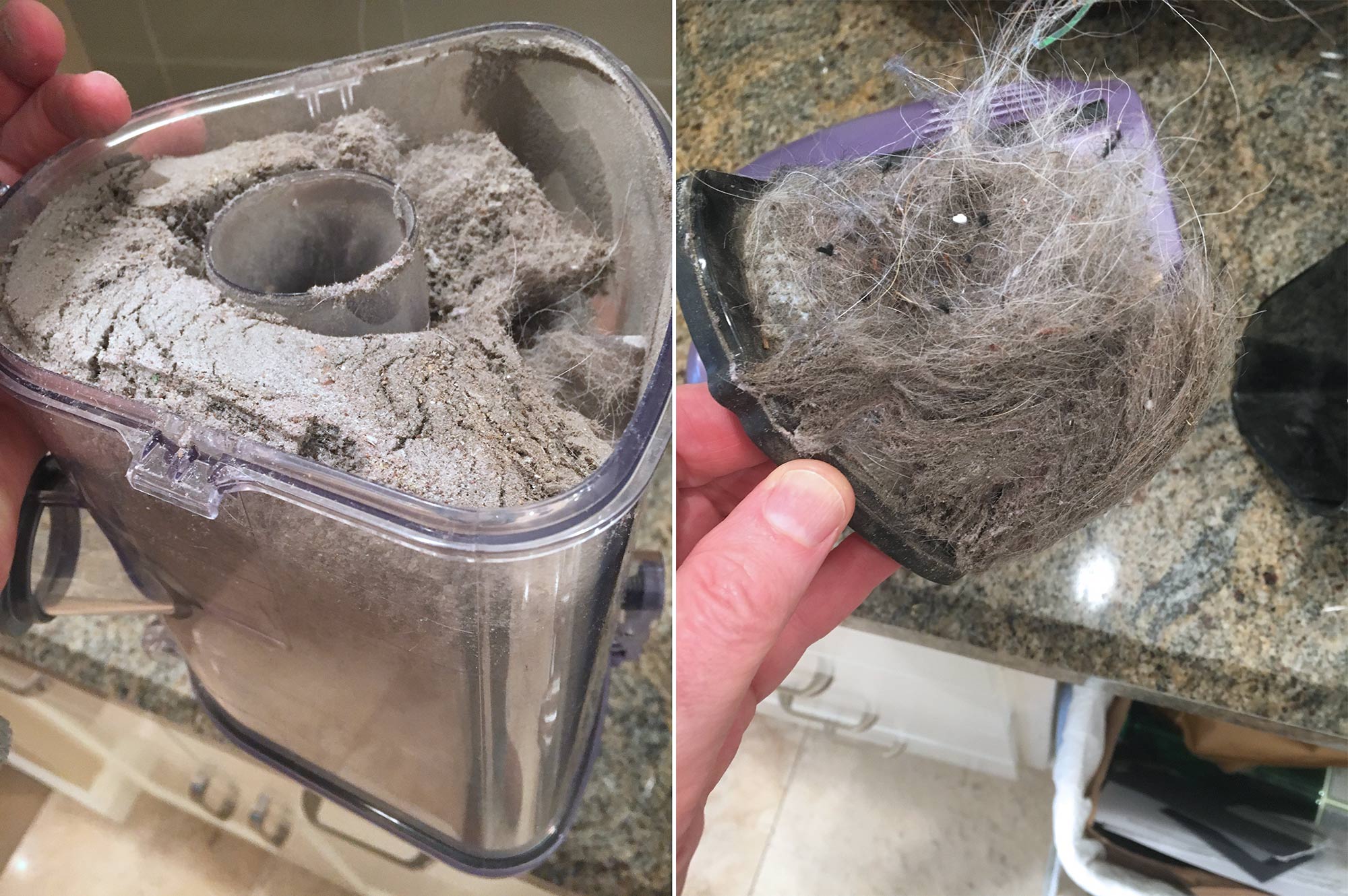
Cats and dogs also shed regularly, and they — along with most other pets, including birds and reptiles — shed microscopic flecks of skin known as dander that can trigger allergic skin and sinus responses in their owners. Also consider that indoor/outdoor pets track in bacteria that can cause intestinal illness.
Something you might not be aware of: many vacuums actually kick back dust and allergens back into the air. Older vacuums are usually the culprits, so look for a newer model that has a HEPA (high efficiency particulate air) filter, like one of the Dyson vacuums. Another option is to add an air purifier — especially in an allergy-sufferer’s bedroom — which should help clear your air of most allergens.
Basically, vacuuming is essential for maintaining good health. A recent study by Indiana University cites that vacuuming (and all home hygiene) increases physical activity for stay-at-home people and improves mental well-being in seeing the rewards of their efforts.
How often should you vacuum each floor type?
Carpets: twice a week
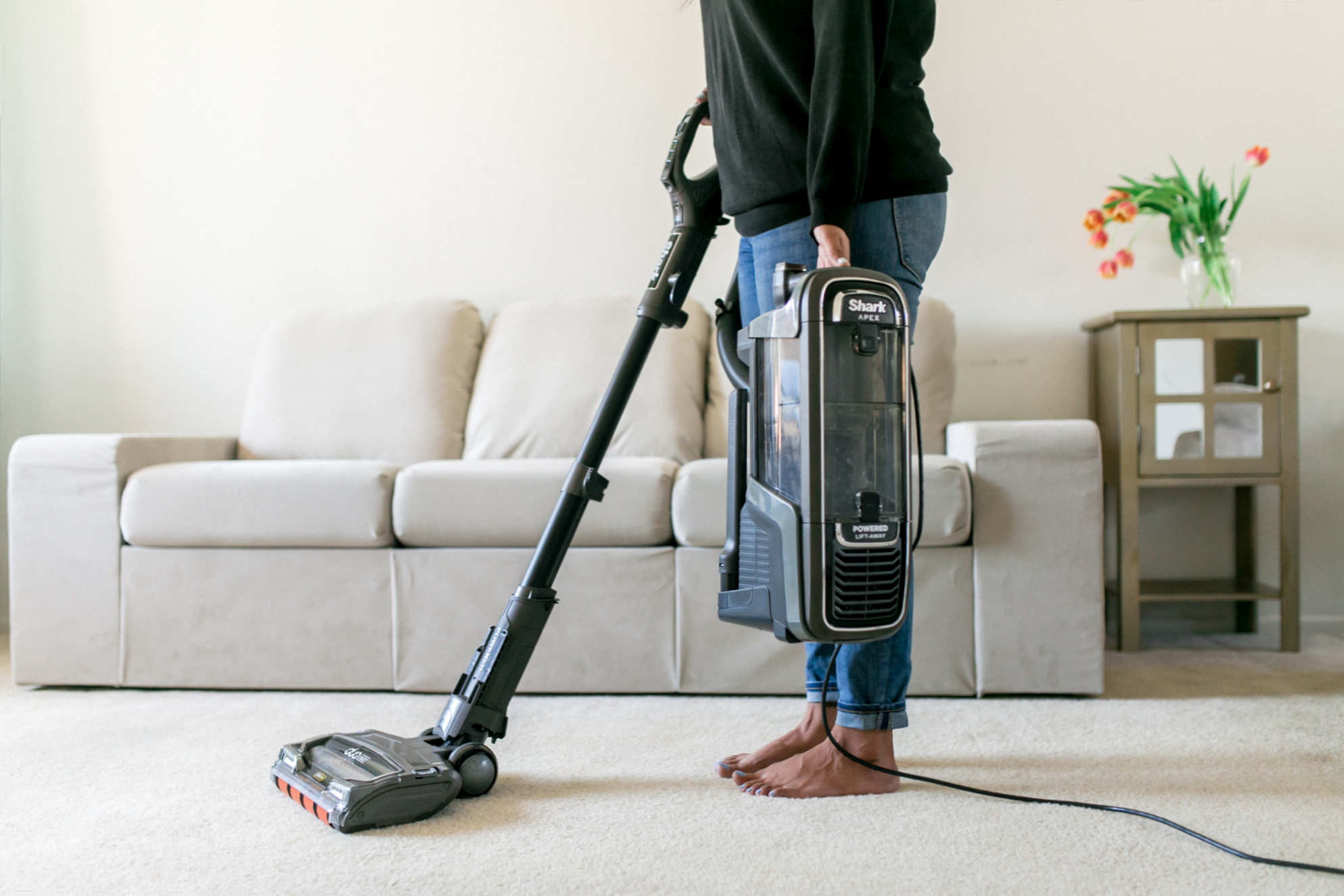
Carpets and area rugs serve another purpose besides decorating the home: They trap airborne particles and thus keep them out of the air we breathe. But other than professional steam-cleaning, the only way to remove the entrapped allergens, dust and tracked-in dirt is by vacuuming them twice a week.
We’ve tested dozens of vacuums, and the best one for thick carpet is a powerful upright vacuum, like the Shark – Apex, which has a lift-away canister that you can easily carry from room to room. The lift-away canister will also help you suck up those dust bunnies under your bed once and for all.
Area rugs: twice a week
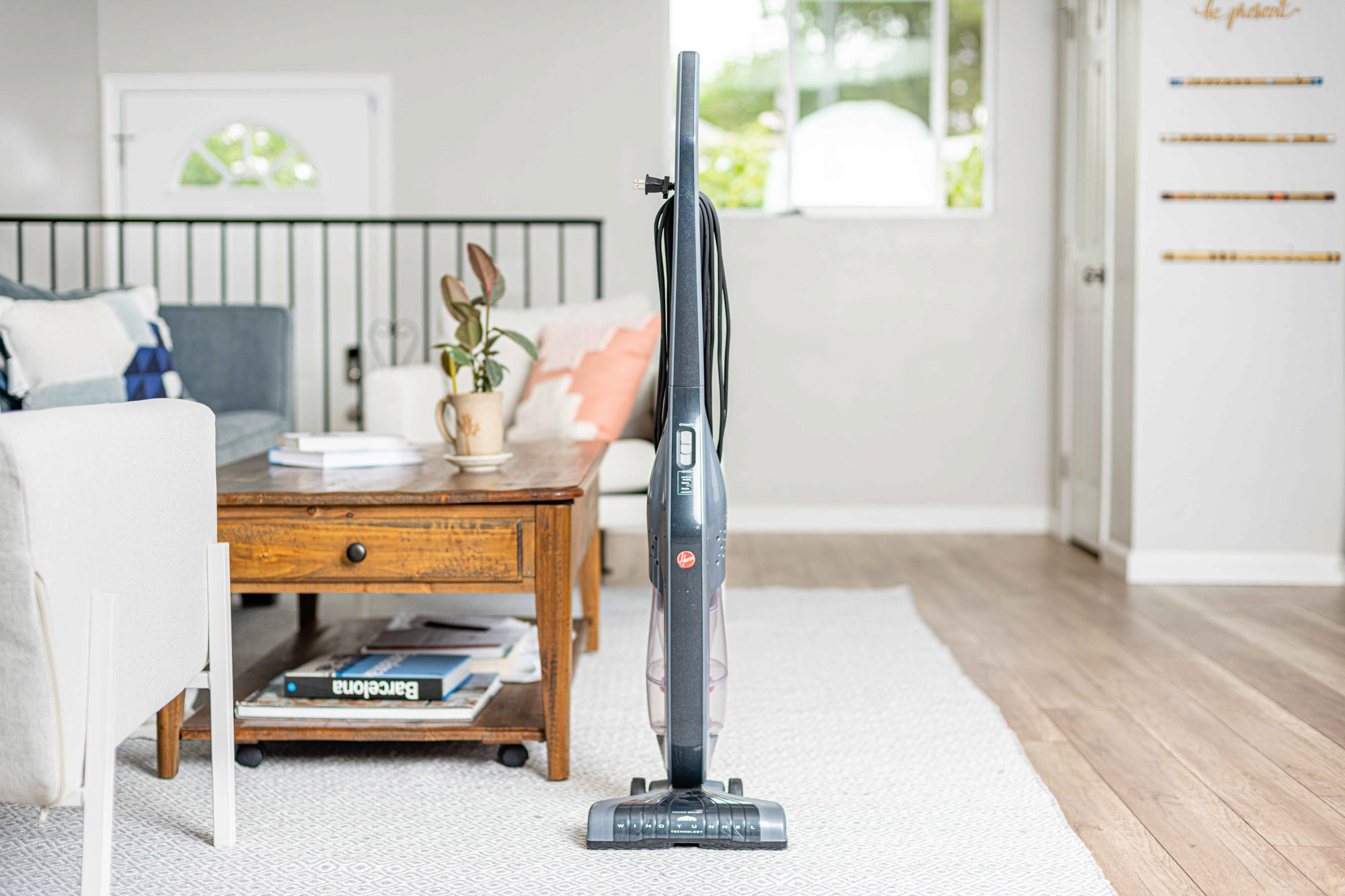
Area rugs should also be vacuumed twice a week, but you’ll need a versatile canister vacuum that can handle multiple surfaces, for example, the Kenmore – Elite. The floors underneath the area rug should be vacuumed as well, and if you have hardwood floors, a vacuum specifically designed to handle hardwood floors will be the most effective.
A general rule-of-thumb is if the area rug covers more than three-fourths of your floor, then the floor beneath the rug can be vacuumed every other week.
Non-carpeted floors: once a week
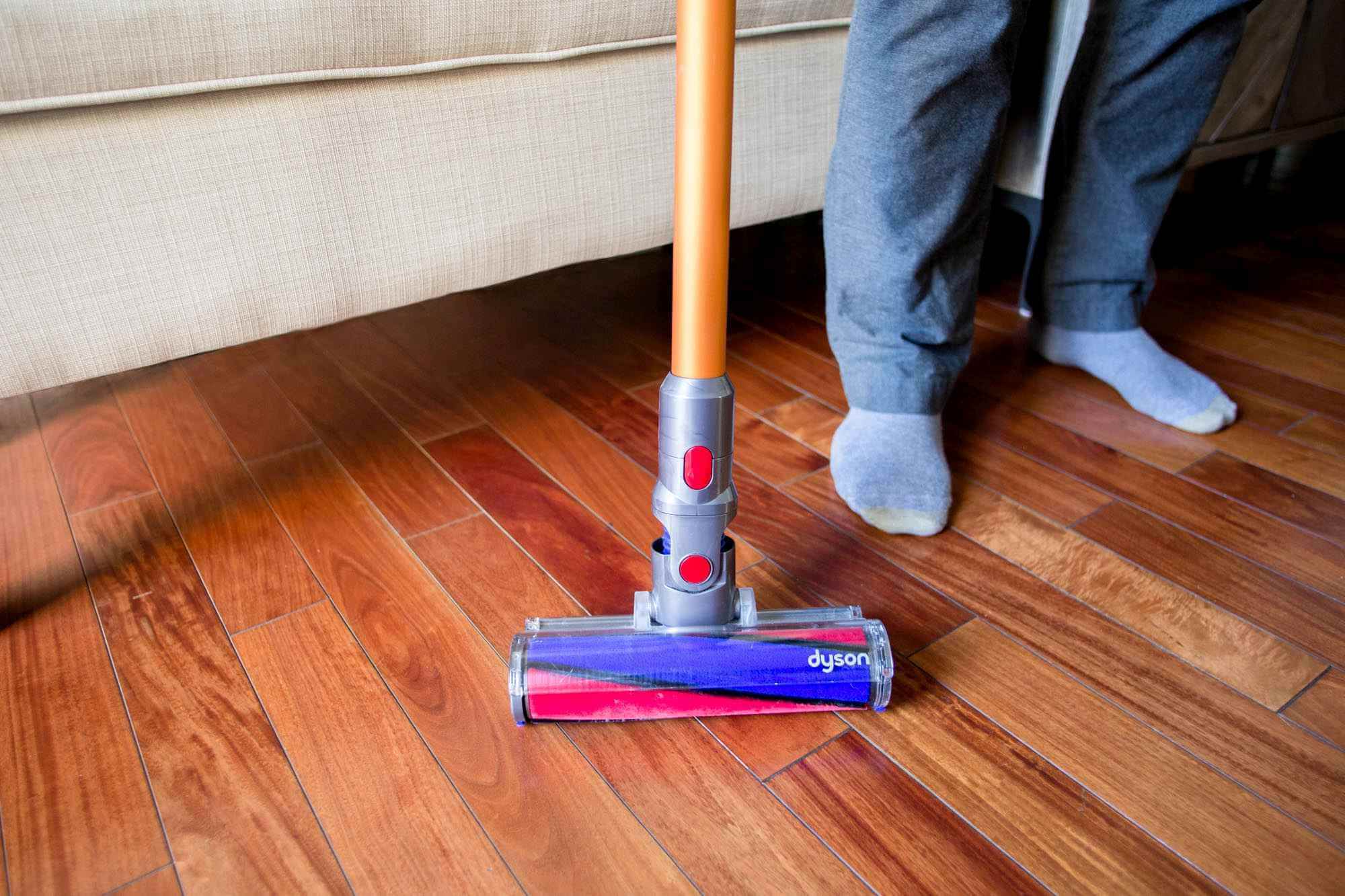
Hardwood floors and kitchen tile floors don’t cling onto dust and bacteria as hungrily as carpets. Their flat construction and sealant or glaze prevent grime from building up. However, dirt can still collect between floorboards, beneath kitchen cabinets, under appliances and in tile grouting.
You only need to vacuum these surfaces once a week, but you’ll need a vacuum that can handle carpets as well as hardwood floors, like the Shark – Rocket, a stick vacuum that’s been specifically designed for both surfaces. For occasional spills and spot-vacuuming on non-carpeted floors and hard-to-reach corners, a handheld vacuum will do the trick, like the budget-priced Dirt Devil – Scorpion.
High-traffic areas: every two days
Hallways, kitchens, mudrooms and children’s play areas are considered high-traffic areas and need to be vacuumed more often than low-traffic areas, such as guest rooms or formal dining rooms used mostly for special occasions.
High-traffic areas should be vacuumed every two days. If all of this vacuuming has you weary just thinking about, there are great lightweight vacuums that will ease arm fatigue and make the job a lot easier.
If you have pets: daily
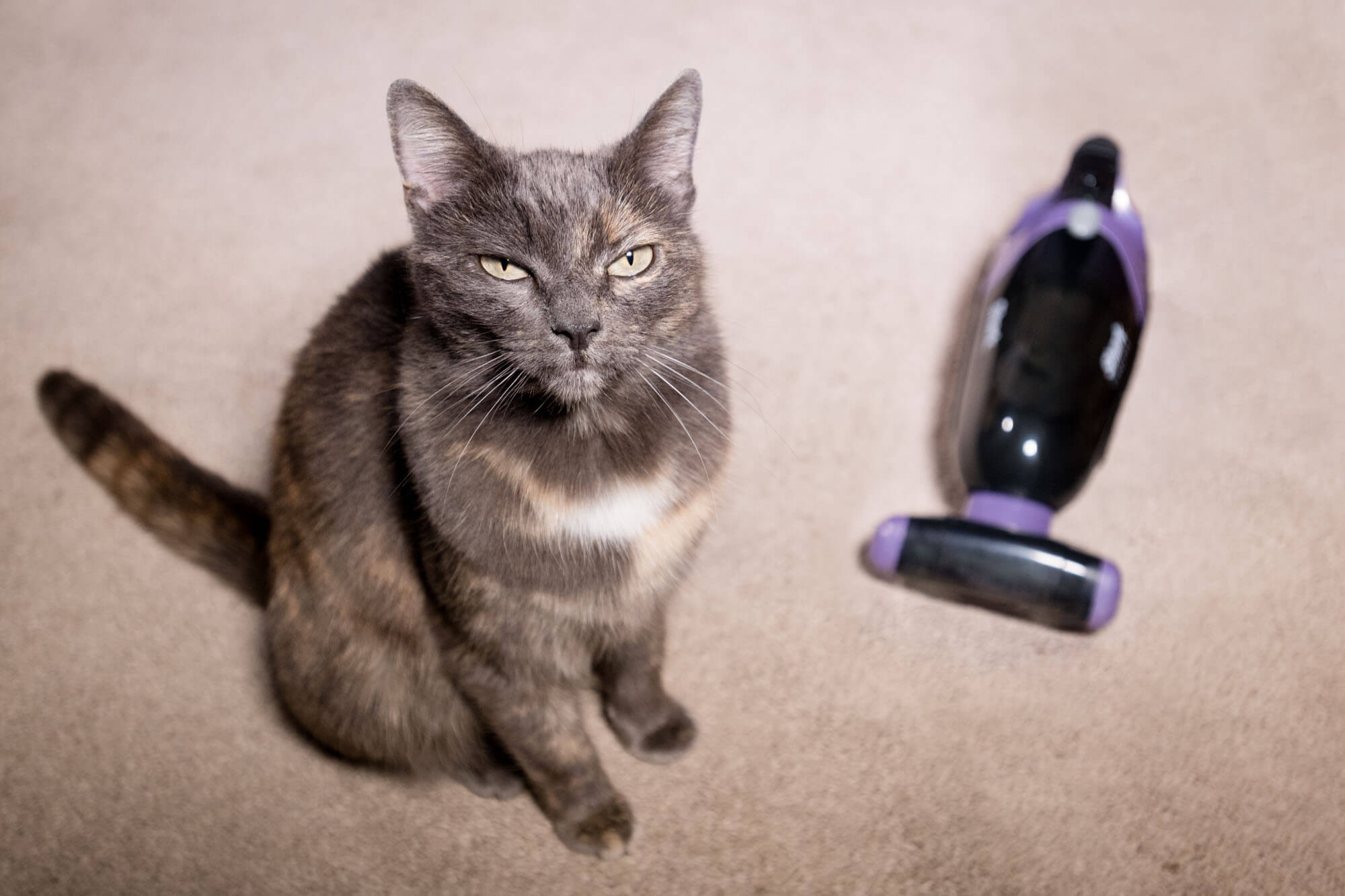
Certain dogs and cats don’t shed as much as others, but they all shed. It’s better to avoid build up of hair and dander by vacuuming every day, especially if you or a family member has allergies. This may seem like an onerous task, but it can be a quick going-over with a pet hair vacuum, like the handy Black+Decker that automatically senses when you’re vacuuming carpet, upholstery or bare floors.
If you only have time for occasional vacuuming, then focus on the areas where your pet spends the most time, like a pet bed, chair or couch and around the litter box.
The post How Often Should You Vacuum? appeared first on Your Best Digs.
]]>The post How Do Bladeless Fans Work? appeared first on Your Best Digs.
]]>What is a bladeless fan?
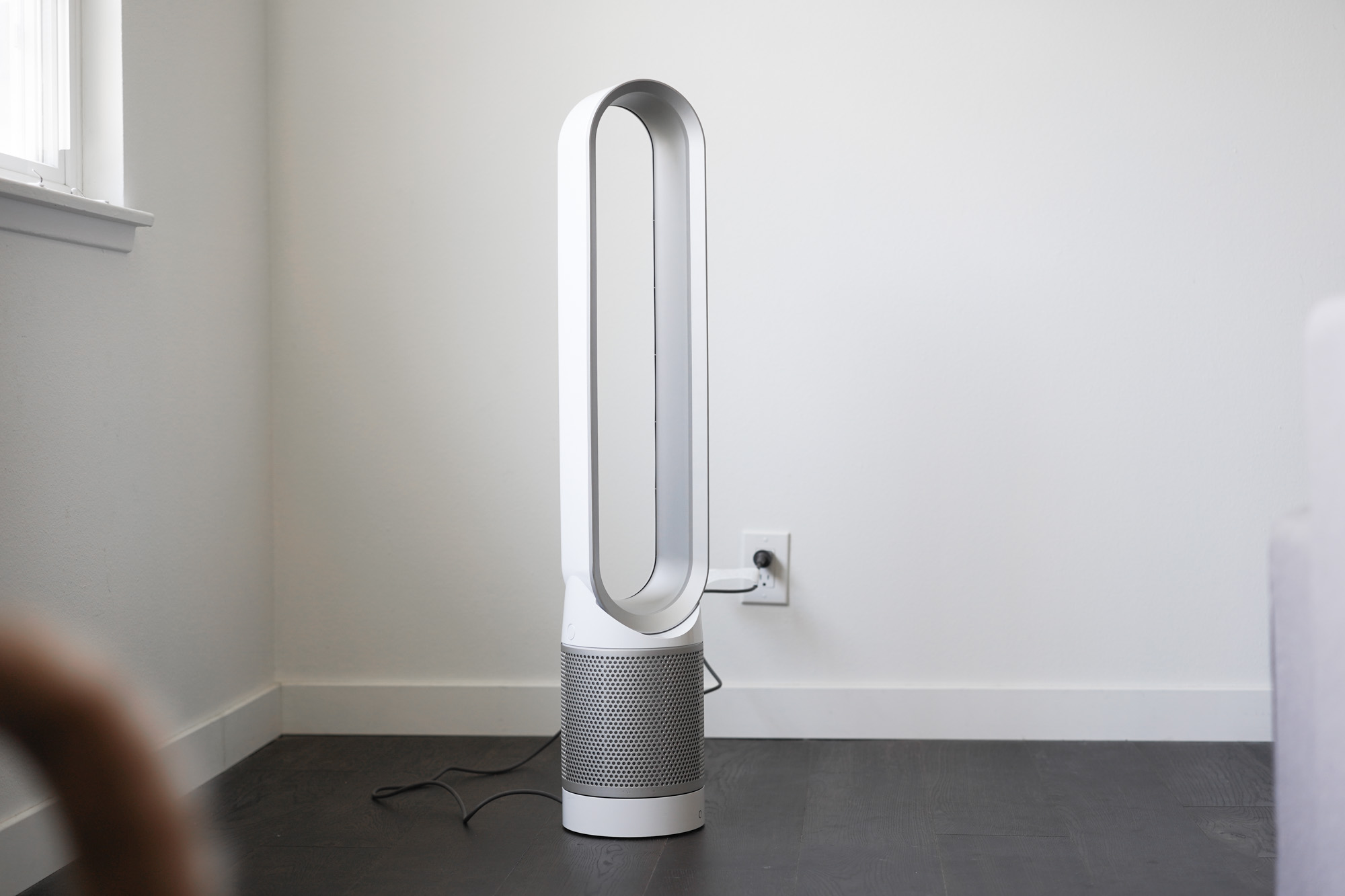
A bladeless fan does, in fact, have a blade, but it’s concealed inside the fan’s motor. The more accurate term for a bladeless fan is an “air multiplier.” The most popular — and the most expensive — air multiplier is the Dyson, and we’ve reviewed the Dyson – AM07 and one of the company’s newest models, the Dyson – TP01, which has a new added feature of an air purifier with a HEPA filter.
The original Dyson air multiplier was a tabletop-style fan, composed of a large hoop that disperses air on top of a squat cylinder that houses its motor. The Dyson – AM07 and Dyson – TP01 are similar in shape to the tower fans we reviewed, but they have the same air-multiplier technology as the original models.
A major downside for some people will be the high cost of any Dyson fan. You could buy one of our recommended tower fans instead and combine it with an air purifier to get an approximation of what the new Dyson fan does.
How does a bladeless fan work?
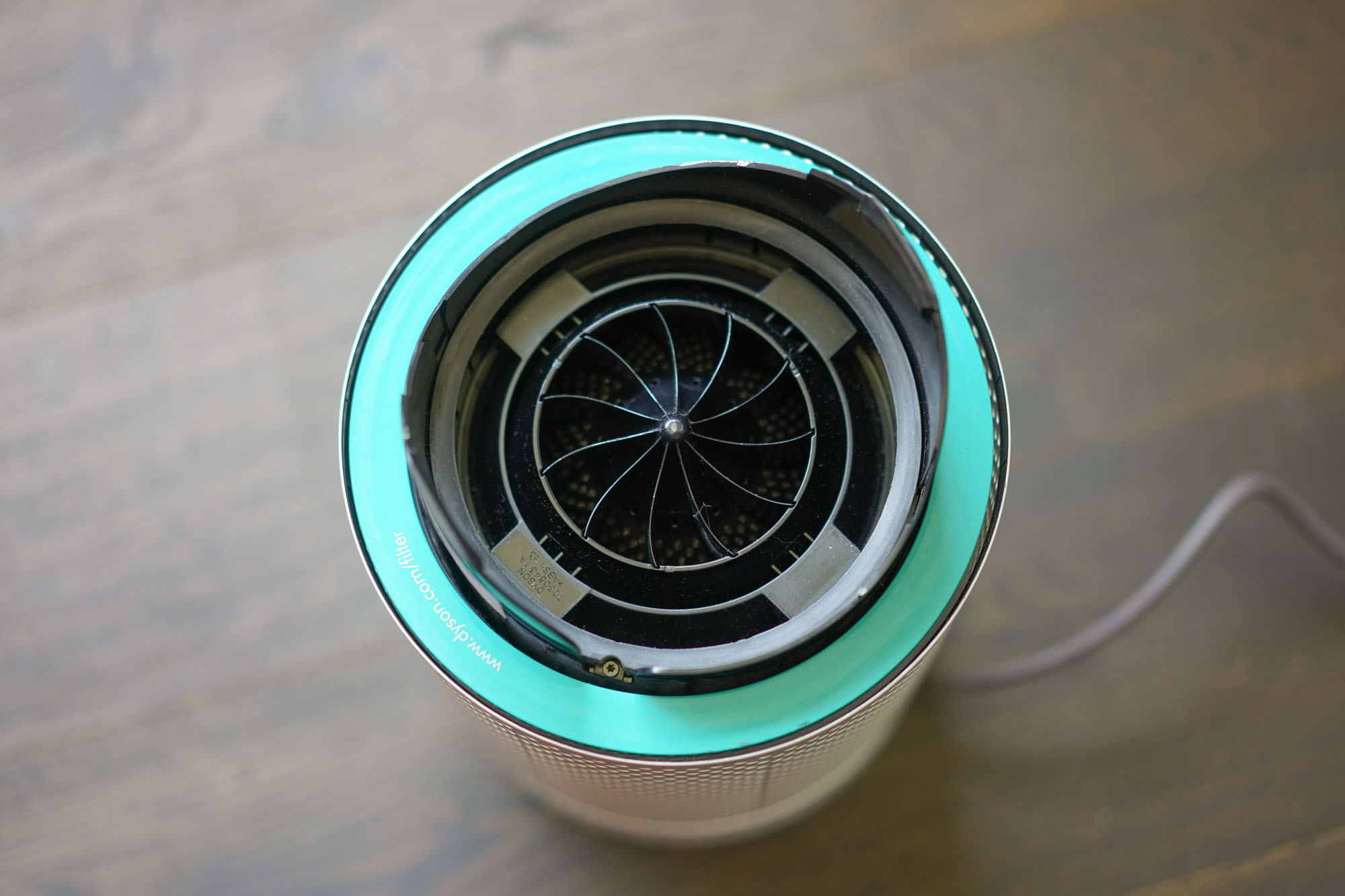
A traditional bladed fan pulls in air and chops it up, with each blade sending a slice of air towards you at high velocity, which creates a turbulent and forceful airflow. The air multiplier works much differently.
Air is pulled in through a small vent in the pedestal base of the fan. A small, brushless motor forces the air through asymmetrically aligned blades — known as a mixed-flow impeller — which increases pressure and airflow.
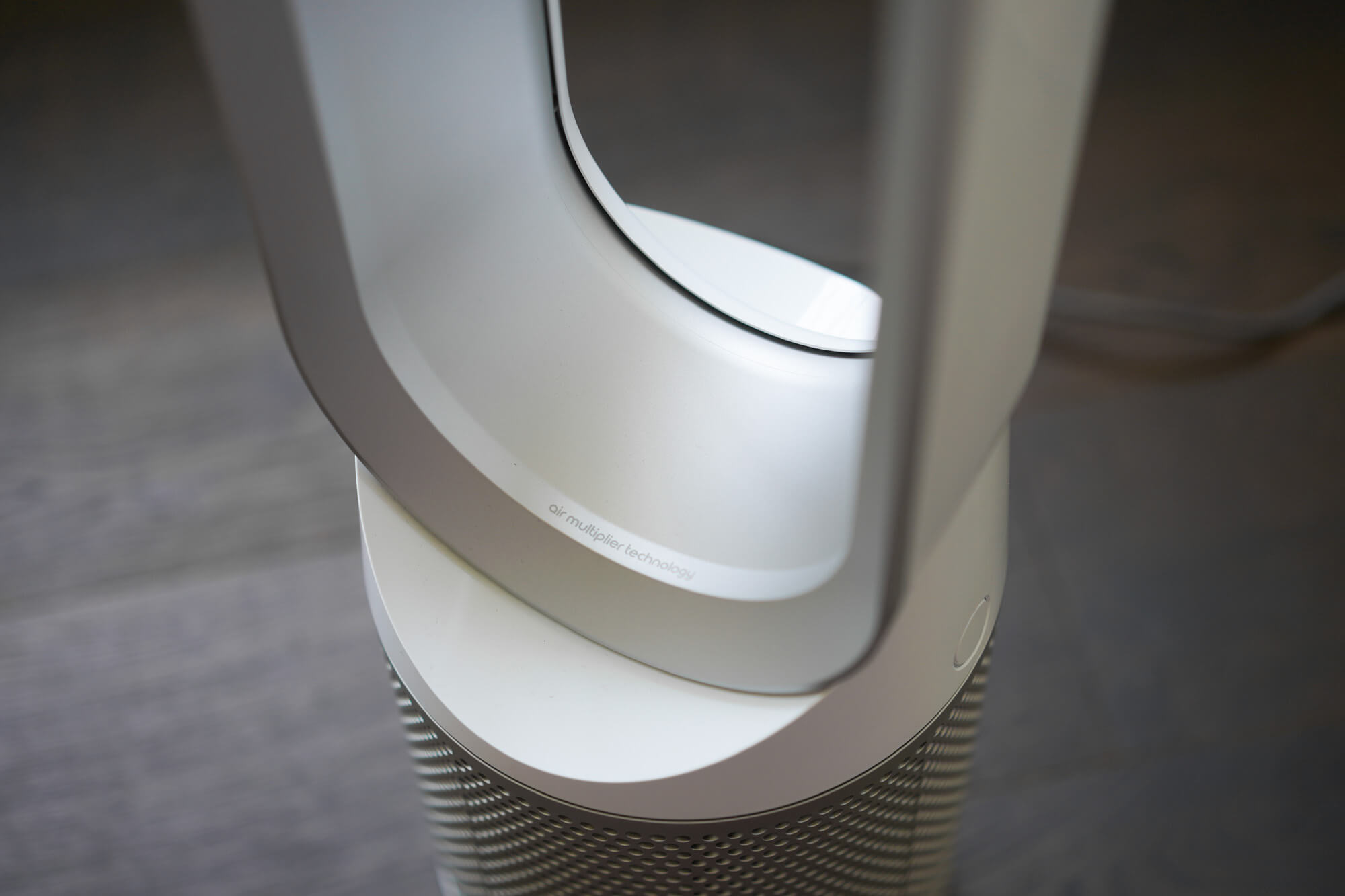
The air is then pushed up through and over a wing-shaped slit at the base of the hoop. This action propels the air up through the hoop at high velocity and — also drawing in the air that surrounds the hoop — multiplies its volume by as much as 15 times.
This simultaneous pushing and pulling motion of air results in a gentle airflow that eliminates the buffeting sensation of bladed fans.
The post How Do Bladeless Fans Work? appeared first on Your Best Digs.
]]>The post Dyson – TP01 Fan & Air Purifier Review appeared first on Your Best Digs.
]]>Table of contents
- Dyson technology
- New features
- Dyson – TP01 vs. Dyson – AM07
- Air purifier performance test
- The bottom line
Dyson technology
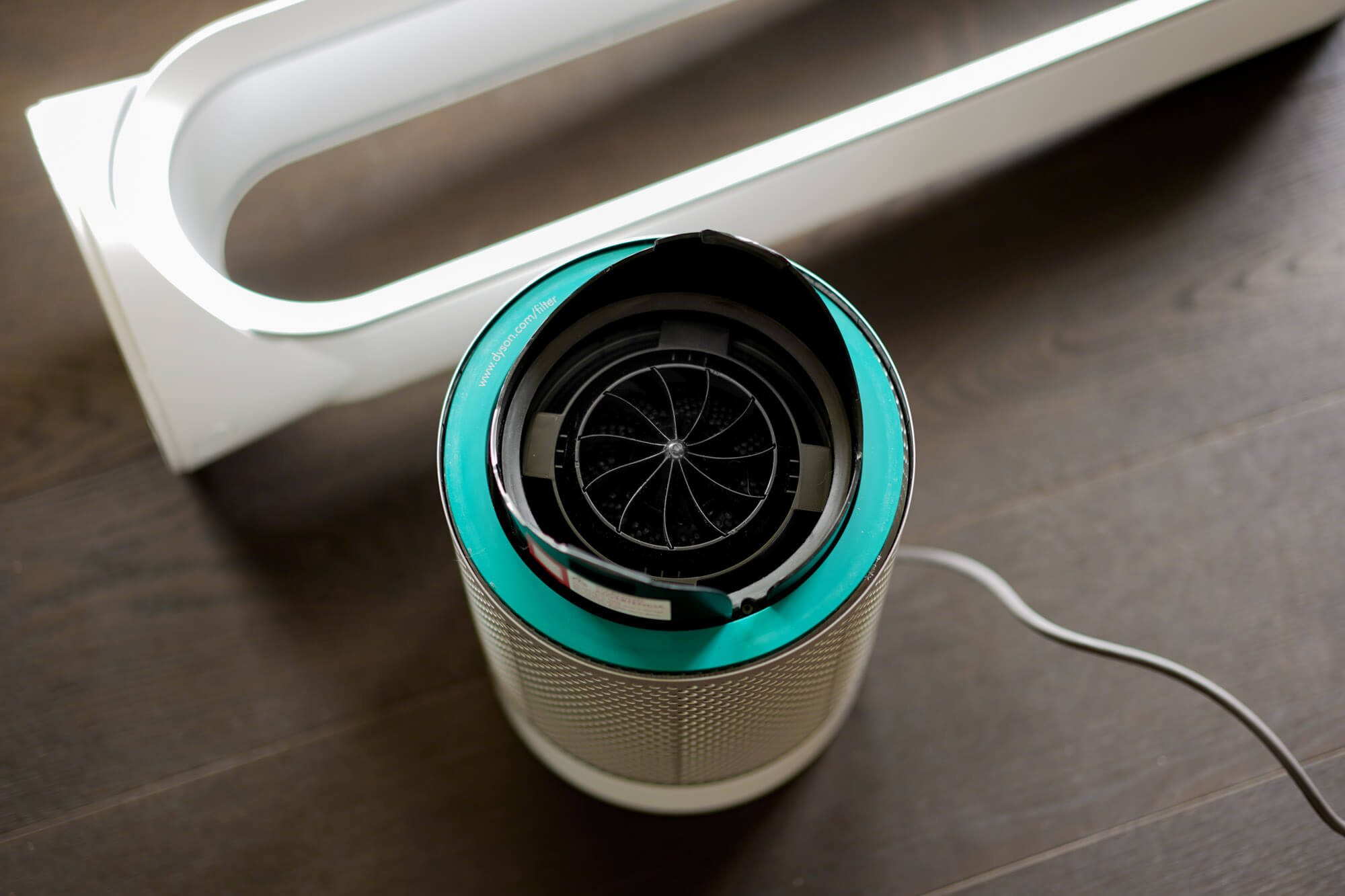
The Dyson company revolutionized vacuums with its cyclone technology and cordless designs, and we’ve reviewed and recommended several of them. Dyson also threw its team of engineers in designing a new type of fan, the so-called bladeless fans.
There’s no denying the amazing technology in a Dyson fan or more precisely — as we explain in our article about how bladeless fans work — an air multiplier. In brief, a Dyson’s motor is designed to force air upwards through the upper body’s loop. It then pulls in air surrounding the loop and multiplies the air volume before expelling it outward.
This explanation is still probably too technical, but put simply, the result is that the airflow is smoothed out. You feel a constant, gentle breeze, rather than the buffeting sensation you feel from a traditional bladed and oscillating fan.
The first Dyson fans were table fans, and instead of a loop, the upper body was a silver or black ring, something you might catch Sauron peering through. They were also notoriously noisy. The company spent three more years researching how to muffle the motor’s sound, and they succeeded in designing a much quieter model, which is now Dyson’s claim to fame. When we tested the Dyson – AM07 with other tower fans, it was quieter, but only by a few decibels, and the difference was not noticeable when compared with our top (and much cheaper) pick, the Seville Classics – UltraSlimline.
Dyson continues to refine their air multiplier’s technology, and Dyson has incorporated air purifiers, heating elements, humidifiers and air-pollution sensors into the newest models.
New features
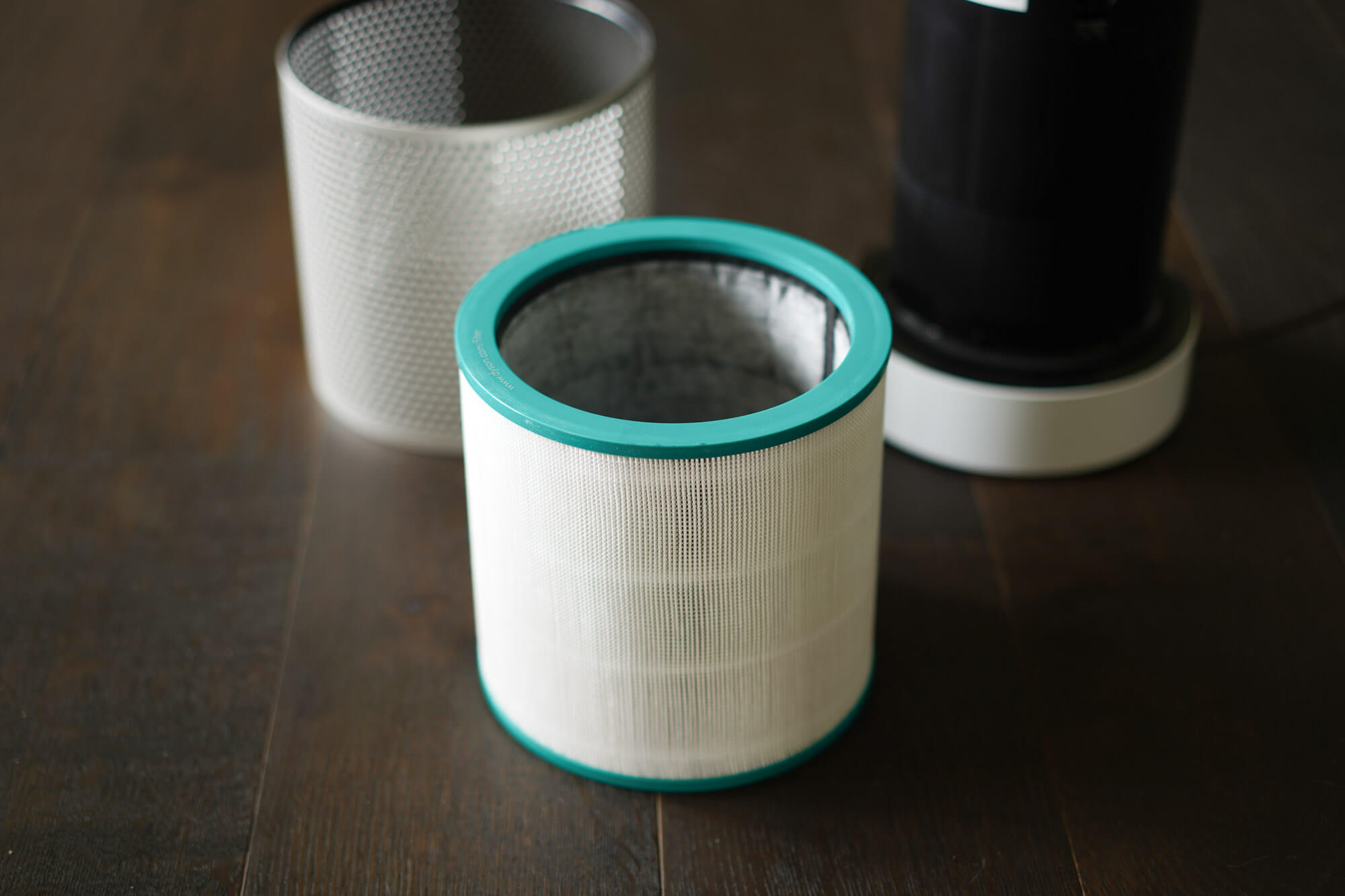
The TP series, also called Dyson Pure Cool, has a built-in air purifier with a high efficiency particulate-arresting (“HEPA”) filter, which Dyson claims only needs to be replaced once a year. The Pure Cool air multipliers pull in dust and allergens and expel clean air that is virtually free of pollutants (a 99.97% reduction of particles in air that passes through the filter).
The TP02 is Wi-Fi compatible and has an automatic mode for air purification, meaning it can turn the fan speed up when a sensor detects pollution in your air. The TP03 was an updated version of the TP02, but it’s no longer available.
The TP04 is the most significant change, adding an LCD display, thicker filters, and more pollution sensors to show you a more complete picture of your air quality. Its oscillation can be set up to 350 degrees to reach every corner of a room. You can also change the airflow direction, and a nighttime setting lowers airflow to a quieter level.
There’s no question that the TP series is remarkable, but is it worth almost $600 for the ability to see your air quality status in an app? You could buy a tower fan and an air purifier with a HEPA filter and perhaps get better results for less than half the cost.
As much as we love technological marvels, we found the newer models of the TP series too expensive and chose to test the TP01 — not exactly a bargain at $400 — to see how it compared to the discontinued AM07.
Dyson – TP01 vs. Dyson – AM07
| Product | Price | Air Flow Speed | Noise Level | Degrees of Oscillation | Power Usage (KwH) |
|---|---|---|---|---|---|
| Dyson - TP01 | $$$$ | 7.8 mph | 63 dB | 70 | .05 |
| Dyson - AM07 | $$$$ | 6.3 mph | 61 dB | 70 | .05 |
| Seville Classics - UltraSlimline | $ | 8.0 mph | 68 dB | 95 | .05 |
The Dyson – TP01 is very similar to the Dyson – AM07: It has 10 speeds that can be easily controlled manually by simply holding its power button, which increases the airflow incrementally. The TP01’s remote control does the same function, but you can also program the amount of time the fan will operate at a selected speed. To ensure the remote control won’t get lost or mixed up with other remotes, you can attach it magnetically to the top of the unit.
We tested the Dyson – TP01 for a full week, running it 24 hours a day in a bedroom that is approximately 155 square feet. We then tested it intermittently in an irregularly shaped living room/dining room that is approximately 400 square feet.
Levels 1 through 3 are intended for just removing low levels of dust in an empty room, since the airflow is minimal. However, in the bedroom, cooling at level 3 was quite effective. Overall the Dyson performed better in the smaller room. Despite Dyson’s marketing that the TP series can cool a large, airy room, we did not find that to be the case. Like other Dyson fans, it oscillates (only by using the remote control) at a limited 70-degree angle, which was fine for the bedroom. In the living room, however, even at its highest level, we felt almost no cooling from either side of the fan.
In our previous testing of tower fans, the AM07 had only modest airflow at 6.3 mph, while the inexpensive Seville clocked in at 8.0 mph. Dyson clearly made improvements on the TP01’s engineering, since its airflow was noticeably stronger at 7.8 mph. (We were curious about how the upper body’s engineering affected airflow, so we detached it and got a reading of a blustery 24.6 mph.)
As we noted in our review of the AM07, the Dyson’s selling point is its low noise level. The AM07 measured at 61 dB; the TP01 measured slightly higher at 63 dB. So Dyson improved the TP01’s airflow speed, but the noise level is about the same as its older model.
Air purifier performance testing
After receiving many requests from readers, we ran the TP01 tower fan through the same trials as other air purifiers we’ve tested.
Most air purifiers on the market today, even the poor-performance models we don’t recommend, use a similar HEPA-class filter that’s very good at capturing particles. The difference in performance mostly comes from how quickly the air in your room can be filtered — the thick filters slow down the air and require a strong fan. This crucial performance rating is usually certified by an independent agency in a Clean Air Delivery Rate (CADR) test.
The most frustrating thing about Dyson products is the deceptive tactics they use in their marketing. Dyson does some great engineering, but they hide most of the important performance numbers behind misdirection so that you can’t compare their products directly with the rest of the market. Dyson is betting that the high-performance features and unique look will make you love using their products, even if there are some low-performance trade-offs you don’t know about.
In this case, rather than submitting their tower fans for testing with the American Home Appliance Manufacturers’ Verifide program to get an apples-to-apples CADR rating for smoke, pollen and dust, Dyson came up with their own test, something they sometimes call the “POLAR” test. The most important thing about Dyson using their own test is that they don’t have to tell you the result, and you can’t look up a comparison with competing products.
They claim their test is better because of the size of their test chamber, the number of sensors they use, the number of pollutants they test for and the fact that they don’t have a circulating fan in their test chamber. But it doesn’t matter how many gaseous volatile organic compounds they test for, since they haven’t published the results or a performance comparison — not even between their own models.
In our tests, the Dyson’s maximum air velocity was at nearly the same as the best air purifier on its highest speed setting. That’s why it’s good for cooling. But the bigger-volume fan in the Winix moves 40% more air — 393 cubic feet per minute compared to Dyson’s 275. In testing, it took roughly four times longer to get the same improvement in air quality from a Dyson compared to a $130 Winix. The TP01 is also missing the air-quality sensor of its strongest competitors — you have to spend $100 more for the TP02 to get a sensor and Wi-Fi-based control.
At the lowest speed setting, the Dyson wasn’t even creating enough pressure to fill up the plastic bag we were using for air volume testing unless we took the filter off. There’s a gentle breeze because of the excellent air multiplier engineering, but it won’t make much difference for air quality unless you turn it up. For our low-speed test, we bumped the Dyson up to the fourth setting, which gave similar airspeed to the Winix set on its lowest setting.
In a small bedroom, the Dyson will be effective enough to manage dust, but that’s true of many air purifiers that cost less than a quarter its price.
The bottom line
We still can’t deny that the Dyson – TP01 is an amazing piece of engineering, particularly with the new addition of an air filter and the improvement in airspeed over the old model. Although this model doesn’t have an LCD read-out (as the TP04 has) to display what air pollutants have been removed, the air in the bedroom where we tested the TP01 did seem fresher.
We also found that the TP01 kept a smaller room cooler than it did in a large, open-air room, primarily because it does not have a side-to-side airflow. Likewise, while it would manage a certain level of dust in a quiet, well-kept apartment, there’s not enough airflow moving through the filter to make this an effective air purifier if people are stirring up dust every ten minutes.
As it was in our earlier review of an older model, the Dyson’s $400 price tag is its biggest drawback. However, with the inclusion of an air purifier with a HEPA filter that only needs to be changed once a year, you might be able to justify the cost. We still recommend, though, our top pick for tower fan, the Seville Classics – UltraSlimline and our top pick for air purifier, the Winix – 5300-2, as more affordable options.
The post Dyson – TP01 Fan & Air Purifier Review appeared first on Your Best Digs.
]]>The post The Most Comfortable Reading Chairs appeared first on Your Best Digs.
]]>What is the best reading chair for you?
Although we’re partial to propping ourselves up in an oversized sit-up pillow on the couch to read, even the best sit-up pillow can be terrible for posture and lead to an aching back or neck.
If you enjoy reading the latest bestseller or literature classic late into the night with a book light clipped to your book, you’ll want a chair that prevents you from slouching by supporting your lower back and keeps your arms high enough to hold a book comfortably.
Reading chairs come in different sizes, so before buying one, check its measurements. Many modern and retro reading chairs are low to the ground with legs only about five or six inches tall. This style allows you to keep your feet planted firmly and your back erect. You’ll want a seat cushion that gives a little but not so much that you’ll sink into it.
Traditional wingback chairs have slightly angled cushions that force you to sit into their higher backs. Although most wingback chairs are high enough to lean your head back, sometimes you might need a cushion to support your neck.
Most people consider a recliner to be the most comfortable chair for reading and relaxing. If you have the room in your home, a recliner could be a good option and may provide relief from lower back ache. However, your body needs to fit properly into the recliner and keep your feet elevated above your heart to have any benefit.
The post The Most Comfortable Reading Chairs appeared first on Your Best Digs.
]]>